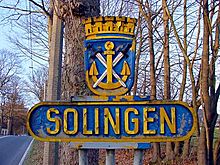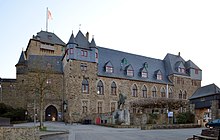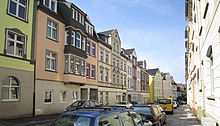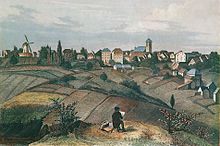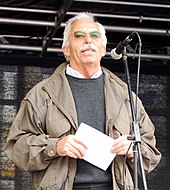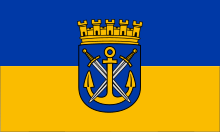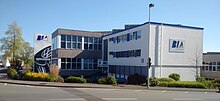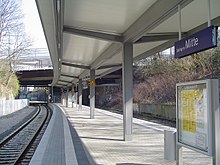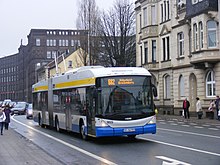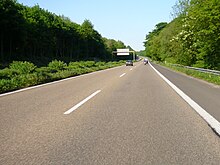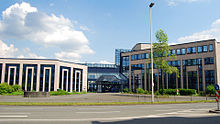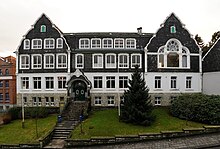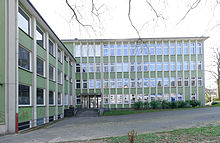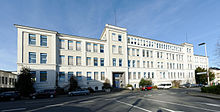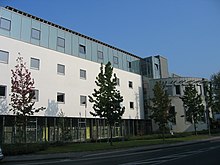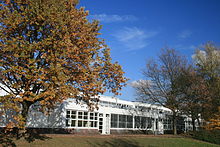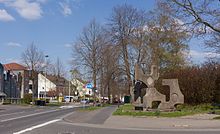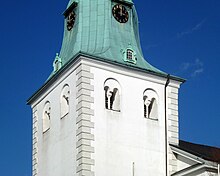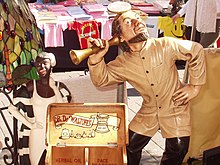Solingen
| coat of arms | Germany map |
|---|---|

|

Coordinates: 51 ° 10 ' N , 7 ° 5' E |
| Basic data | |
| State : | North Rhine-Westphalia |
| Administrative region : | Dusseldorf |
| Height : | 221 m above sea level NHN |
| Area : | 89.54 km 2 |
| Residents: | 159,245 (Dec. 31, 2019) |
| Population density : | 1778 inhabitants per km 2 |
| Postcodes : | 42651-42659, 42697, 42699, 42719 |
| Primaries : | 0212, 02196 (Höhrath) |
| License plate : | SG |
| Community key : | 05 1 22 000 |
| LOCODE : | DE SOL |
| NUTS : | DEA19 |
| City structure: | 5 boroughs |
City administration address : |
Walter-Scheel-Platz 1 42651 Solingen |
| Website : | |
| Lord Mayor : | Tim Kurzbach ( SPD ) |
| Location of Solingen in North Rhine-Westphalia and in the administrative district of Düsseldorf | |
Solingen is an independent city in the administrative district of Düsseldorf in North Rhine-Westphalia . Solingen is part of the Bergisches Land and the Bergisch city triangle , the city is also part of the Rhineland Metropolitan Region and the Rhineland Landscape Association . Solingen ranks 51st among the largest cities in Germany .
The city of Solingen is the center of the German cutlery industry , and companies from Solingen are world leaders in the manufacture of blades in particular . Around 90 percent of German cutlery and cutlery manufacturers are based in Solingen. Solingen cutlery is legally protected with the indication of origin Solingen by the Solingen Ordinance since 1938. This makes Solingen the first city in the world to protect cutlery products in this way. Since March 19, 2012 Solingen has had the official name affix Klingenstadt .
The most famous landmarks of the city are Schloss Burg an der Wupper and the highest railway bridge in Germany at 107 meters, the Müngstener Brücke . In addition, Solingen has an electric trolley bus system , which is one of the largest in Europe.


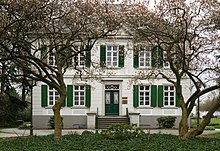

geography
location
Solingen is about 24 kilometers east of Düsseldorf and about 35 kilometers north of Cologne .
Expansion of the urban area
The urban area of Solingen has a size of 89.54 km² . The largest east-west extension is 15.68 kilometers, the largest north-south extension 11.7 kilometers. The geographical center of the city is behind the house at Damaschkestrasse 17 in Solingen-Mitte. It was officially identified and marked with a boulder. The city boundary has a total length of 62 kilometers, of which the Wupper as a river forms a natural city boundary of approx. 26 kilometers. Solingen is located at 51 degrees 10 minutes north latitude and 7 degrees 3 minutes east longitude and thus on the same latitude as Leipzig , London and Quebec and on the same longitude as Monaco and Basel . The highest point in the city is at 276 meters above sea level at the former Gräfrath water tower, today's light tower . The lowest point is in the Ohligser Heide and is only 53 meters above sea level.
Neighboring communities
The following cities and districts are directly adjacent to the city of Solingen, they are named starting in a clockwise direction in the northeast:
Wuppertal and Remscheid (both independent cities ), Wermelskirchen and Leichlingen (both Rheinisch-Bergischer Kreis ), Langenfeld , Hilden and Haan (all Mettmann district ).
|
|
|
|
|
|

|
|
|
|
|
|
Urban structure
The current Solingen urban area emerged from the amalgamation of several small towns. Solingen has only existed in its current size since 1975 with the incorporation of the town of Burg an der Wupper .
Most parts of the city have their own small-scale center around which they have arisen. The development history of the Solingen districts is sometimes very different. The Gräfrath district around the old Gräfrath monastery was created as early as the 1190s , while Ohligs, for example, only flourished with the connection to rail traffic from the 1870s . In addition to the main thoroughfares, the individual districts are often also connected by smaller streets, some of which are serpentine , which cross the entire urban area. The districts of Gräfrath, Wald, Mitte, Höhscheid and Merscheid are essentially located on five smaller ridges that run from east to west. Solingen has six deep and heavily forested stream valleys. These are in detail (from north to south) the Ittertal , the Lochbachtal , the Viehbachtal , the Nacker Bachtal, the Pilghauser Bachtal and the Weinsberger Bachtal.
The original settlement in Solingen took place in the so-called Hofschaften , i.e. in a group of a few houses. These often formed around a grinding dome , a mill or a hammer mill , the widespread use of which favored the many streams in the Bergisches Land. The farms that still exist today are therefore outside the main thoroughfares in the stream valleys or on the Wupper.
Landmarks
Compared to the boundaries of the current city districts, the old district boundaries differ considerably. Dorp , which had completely disappeared from the map, was incorporated into the old town of Solingen and belonged to the Höhscheid district. a. today's district Aufderhöhe. Only the boundaries of the Burg district are identical to the old district boundaries.
City structure
Today's city area of Solingen consists of five city districts with their own district representatives . The westernmost district Ohligs / Aufderhöhe / Merscheid is the largest with a population of over 43,000, Gräfrath in the north is the smallest Solingen district with 18,000 inhabitants.
The five boroughs:
The eight districts:
Solingen residential areas:

Solingen has a lot of living quarters , some of these living quarters are typical courts for the Bergisches Land , but their boundaries are not precisely defined. The following list gives an overview of the majority of these residential areas. It is arranged alphabetically according to districts, name additions such as lower or upper are omitted.
- Aufderhöhe: Aufderbech, Birkendahl, Börkhaus, Gosse, Horn, Holzhof, Josefstal, Landwehr, Neu-Löhdorf, Pohligsfeld, Riefnacken, Rupelrath, Siebels, Steinendorf, Ufer, Wiefeldick
- Castle on the Wupper: Angerscheid, Höhrath
- Gräfrath: Central, Flachsberg, Flockertsholz, Focher Dahl, Fürkeltrath, Heide, Ketzberg, Külf, Nümmen, Piepersberg, Rathland, Schieten , Wasserturm, Zum Holz
- Höhscheid: Balkhausen, Bünkenberg, Dorperhof, Friedrichstal , Fürkelt, Glüder , Grünewald, Haasenmühle, Hästen, Katternberg, Kohlsberg, Meiswinkel, Nacken, Pfaffenberg, Pilghausen, Rölscheid, Rüden , Schaberg, Schlicken, Unnersberg, Weegerhof , Wippe, Widdert
- Merscheid: Büschberg, Dahl , Dingshaus, Fürk, Fürker Irlen, Gönrath, Hübben, Hoffnung, Limminghofen, Scheuren, Schmalzgrube
- Middle: Alter Markt, Dorp, Entenpfuhl, Eick, Fronhof, Grunenburg , Hasseldelle, Kannenhof , Kohlfurth , Krahenhöhe, Mangenberg, Meigen, Müngsten , Neumarkt, Papiermühle, Scheidt, Schlagbaum, Schrodtberg, Stöcken, Stockdum, Theegarten, Vorspel, Windfeln
- Ohligs: Bahnhofsviertel, Brabant, Broßhaus, Buschfeld, Caspersbroich , Deusberg, Engelsberg , Engelsberger Hof, Hackhausen, Hansa-Quartier, Keusenhof, Kuckesberg, Kovelenberg, Mankhaus, Maubes , Monhofer Feld, O-Quartier, Olbo-Park, Poschheide , Scharrenberg, Schnittert, Heimspiel settlement on Hermann-Löns-Weg, Suppenheide, Wilzhaus, Verlach
- Forest: Bavert, Demmeltrath, Eschbach, Eigen, Fuhr, Garzenhaus , Itter, Kotzert, Lochbachtal , Rolsberg, Vogelsang, Weyer
Social housing
Currently (2020) there are around 4,000 social housing in Solingen . The housing market concept of the city of Solingen stipulates that at least 33% of the new apartments should be used as social housing. However, this benchmark of 33% has never been achieved. According to the municipal social committee, the city of blades urgently needs more publicly subsidized housing. Any citizen who cannot find an apartment on the free market and does not exceed a certain income limit can apply for social housing. This income limit varies between single and multi-person households. Anyone who rents a publicly subsidized social housing may not exceed the maximum net rent . The current (2020) maximum net rent for social housing in Solingen is € 5.25 per square meter.
In 2018 and 2019 only 41 new social housing were built. Above all, there is a lack of cheap apartments for large families and single households . The need for affordable apartments will grow in Solingen in the future. By the year 2030, almost 3,000 social housing in Solingen will be eliminated, which corresponds to a rate of 75%. According to the Solingen Greens , this is the largest decline in social housing in all of North Rhine-Westphalia. The main reasons for the low number of social housing are that the binding period for net cold rents has expired, the lack of suitable building land for new development areas in Solingen and the very high construction costs for new housing.
Private housing market
Solingen is becoming more and more attractive as a place to live. This emerges from the real estate market report 2020. For this purpose, all sales contracts from 2019 in Solingen were evaluated and analyzed. The expert committee also found that around a third of the buyers of real estate in Solingen had their place of residence outside of Solingen at the time when the purchase contract was notarized. A total of almost 1,500 purchase contracts were concluded in Solingen in 2019. Currently (2020) the new building costs in Solingen are around 3500 euros per square meter. The Solingen city administration supports the construction of residential houses. Among other things, she has created a cadastre with possible building plots. In addition, vacant lots were identified in which new residential buildings could be built.
According to Haus & Grund Ohligs e. V. register up to 90 potential new tenants for a vacant apartment for the districts of Ohligs and Aufderhöhe , for Solingen-Mitte there are fewer than 10 interested parties. While the cold rents in Ohligs are on average between 9 and 11 euros per square meter, the average in downtown Solingen is 7 euros per square meter. According to real estate agents, the very strong demand for condominiums in the Solingen district of Ohligs / Aufderhöhe / Merscheid will last as long as prices stagnate at a high level on the Rhine.
climate
Solingen is located in the north-west German climatic area, whereby the maritime , subatlantic climate leads to generally cool summers and relatively mild winters. Influences of the relief and land use lead to different manifestations of the climate parameters temperature , humidity , wind , precipitation and radiation . In winter, for example, there can be a few centimeters of fresh snow in Gräfrath , while it is raining at the same time in the much flatter Ohligs. The annual mean temperature is 10.2 ° C.
After the neighboring city of Wuppertal, Solingen is one of the cities in Germany with the highest amounts of precipitation. This is primarily due to the fact that the Bergisches Land is the first significant elevation from the northwest, so that clouds accumulate in many cases.
The following data refer to the period from April 2015 to March 2020. Measurements were taken at the weather station in Wuppertal- Buchenhofen , which is located on the city limits of Solingen-Gräfrath.
| Solingen | ||||||||||||||||||||||||||||||||||||||||||||||||
|---|---|---|---|---|---|---|---|---|---|---|---|---|---|---|---|---|---|---|---|---|---|---|---|---|---|---|---|---|---|---|---|---|---|---|---|---|---|---|---|---|---|---|---|---|---|---|---|---|
| Climate diagram | ||||||||||||||||||||||||||||||||||||||||||||||||
| ||||||||||||||||||||||||||||||||||||||||||||||||
|
Average monthly temperatures and precipitation for Solingen
Source:
|
||||||||||||||||||||||||||||||||||||||||||||||||||||||||||||||||||||||||||||||||||||||||||||||||||||||||||||||||||||||||||||||||||||||||||||||||||||||
Natural spaces
Natural structure
According to the structure of the former Federal Institute for Regional Studies, the largest part of the Solingen urban area is predominantly natural in the Mittelberg plateau within the Rhenish Slate Mountains . The western edge area near Ohligs is already in the edge zone of the slate mountains in the transition to the Lower Rhine Bay .
The natural spatial subdivision that took place in 1963 divides the urban area into six natural areas. The Solingen ridge stretches north-south from Gräfrath to Hästen and is based on rocks from the slate mountains. To the east of this, the ridge drops steeply into the western Wupperengal valley , which continues in Unterburg in the further course of the river in the Lower Wuppertal . To the west of the Solingen ridge are the Ohligser Terrassenriedel , which are clearly stepped with a terrain edge , which are part of the higher-lying old diluvial Rhine terraces. The districts of Wald, Merscheid, Höhscheid, Widdert, Aufderhöhe and the eastern part of Ohligs are located in this natural area. The heather area of the Ohligser Heide and the area south of it to Rupelrath belong to the Hilden-Lintorfer sand terraces . The Solingen urban area near Burg to the east and south of the Wupper is geologically and naturally part of the Remscheid Bergland .
Landscapes
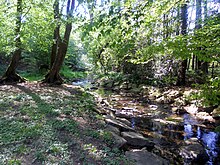
The forest areas and the agriculturally used areas each make up about a quarter of the total area of Solingen. In addition, there are water bodies with a share of around 1.4 percent. This does not include open spaces as well as parks and green spaces, the latter accounting for an additional share of around 4.2 percent. Almost half of the urban area, almost 4000 ha , make up landscape protection areas , around 770 ha , around 9 percent, are designated as nature reserves . Some landscape objects are under special protection as natural monuments . In the inner-city areas of Solingen there are 157 trees and in the open spaces individual objects, field trees or small areas at 113 locations, see also the list of natural monuments in Solingen . The Solingen-based Biological Station Mittlere Wupper has made nature conservation its task in the entire Bergisch city triangle . In addition, the Foundation for the Protection of Animals and Nature Solingen looks after numerous biotopes in the city area , many of them in the stream valleys.
Away from the more densely populated urban areas, there is a multitude of natural and cultural landscapes . Due to the topography and the sometimes large height differences in the urban area, large, built-up areas are rather rare. Again and again, wooded valleys or sloping open spaces appear in parts, which separate individual living spaces from one another.
In the western part of Ohlig there is the Ohligser Heide, a large, partly wooded, former heathland area which, in addition to forest and heather, also has a moor landscape . Another dense forest area is around the southeastern part of the town of Burg. Along the Wupper, the partly steep slopes of the Wupperberge are often wooded, partly they also consist of rock formations. Numerous hiking trails open up the Wupper valley from Solingen.
The many stream valleys between the ridges, which have a total length of around 200 kilometers, are characteristic. To the left and right of the brooks there are mostly dense forests or meadows. Small bridges or dams allow the crossing from time to time. Larger agricultural areas can be found everywhere in the city, but these are preferred around the Gräfrath district and in the Höhscheid and Widdert area.
Waters
The distinctive elements of the landscape also include the various standing and flowing waters , although they only make up 1.4 percent of the total area. In addition to the largest river, the Wupper , there are countless small streams in the city area, most of which flow into the Wupper or the Itter , and some of them run underground. Many of them flow in wooded stream valleys. The Itter itself rises in the Gräfrath district, flows largely along the city limits to the neighboring town of Haan and flows into the Rhine at Urdenbach .
The Sengbachtalsperre near Höhrath in the south of the city supplies large parts of Solingen with drinking water. Further examples of artificially created standing water are the approximately 1.5 ha large Stielsteich, which the neighboring Kronprinz company once created for industrial purposes (other sources claim it was an exhausted clay pit from the Bracken & Cie. Brickworks full of water) and the Reservoir in the Ittertal.
City history (around 965–1993)




The first settlement in today's Solingen city area probably took place in the 10th century . In a Legacy (Testament) the Archbishop of Cologne Bruno . Is from the year 965 n. Chr from a small farm name Solagon the speech, which could refer to Solingen. The legacy went to the St. Martin Abbey in Cologne. The beginning of Solingen historiography is roughly identical to the reign of Emperor Otto III. (996 to 1002). At that time (around 965) today's Solingen urban area was almost 100% forested and the impassable area was only very sparsely populated (less than 100 people). As in the entire region of the Bergisches Land, so-called single farm settlement with very few residents was initially common. The Solingen indigenous population , mostly simple farmers and craftsmen, have 100% self-sufficient . The first secure mention of a Christian community in Solingen can be found in a document dated May 3, 1019 by the Archbishop of Cologne, Heribert of Cologne . In this document, the property is documented over a part of today's Solingen district of Wald: curtim et ecclesiam que Walda vocatur ( Fronhof and church named Wald).
The former Solagon estate developed over centuries into a simple clearing settlement in the Bergisches Land . Today the Solingen district includes the middle, roughly the settlement area of the first Solingen citizens.
The “de Berg” family of counts from Altenberg moved to today's Solingen district of Burg around 1133 and built a castle on the Wupper River under the name: Schloss Burg . Burg Castle became the seat of the aristocratic family and the Counts of Berg ruled over the Bergisches Land, which was named after them . Since the beginning of the 13th century (around 1210) there is evidence of blade craftsmanship in Solingen. The first grinders settled on the numerous streams in the Solingen city area. The grinders organized themselves in so-called guilds ( called brotherhoods in Solingen ) at the beginning of the 14th century and were of particular importance for the Solingen economy. In 1374 Solingen received city rights. The people of Solingen at that time always had to pay a tax in autumn and had permission (as it is in the document text) to elect a mayor. Since the "sworn aldermen" should speak right. A weekly market and a fair in October were allowed. In 1492 and 1535, two devastating fires raged in the city. The plague broke out in Solingen in 1614. Burg Castle was almost completely destroyed during the Thirty Years' War . Between 1756 and 1763, looting troops repeatedly marched through the city and massively damaged Solingen's urban development.
The city of Solingen was part of the Duchy of Berg until the French occupation in 1808 . The Duchy of Berg was last owned by the Bavarian King Maximilian I Joseph due to inheritance . On March 15, 1806 he ceded the Duchy of Berg to the French Emperor Napoleon I in exchange for the Principality of Ansbach . Under Emperor Napoleon, the duchy became the Grand Duchy of Berg and was completely secularized . Napoleon appointed Joachim Murat as the new Grand Duke, who by a decree of October 13, 1807 reorganized the municipal responsibilities in his Grand Duchy. The French era ended with Napoleon's military defeat in the Battle of Waterloo in 1815. Overall, the French occupation, which lasted only seven years in the greater Solingen area (1808–1815), was marked by few successes. Above all, there were no real supporters of the Francophone reform policy in the Bergisch population, unlike in the areas on the left bank of the Rhine (Aachen, Cologne, Bonn), where the French period lasted about twenty years. The German landed aristocracy remained critical because of the inadequate agricultural policy, the clergy lost massive amounts of authority due to the secularization and the introduction of the separation of powers and the merchants' guild , which should actually have benefited most from the liberal economic reforms, was defeated by the Napoleonic wars and the resulting breakdown in sales markets Abroad, weakened rather than strengthened. The bulk of the Solingen population (over 90%), especially the simple farmers and artisans, suffered most from the French reprisals , and the precarious families in particular suffered the consequences of the forced recruitment by the Grande Armée . In 1809, under French occupation, the first Solingen newspaper, the “Verkündiger”, was published, a forerunner of today's Solinger Tageblatt .
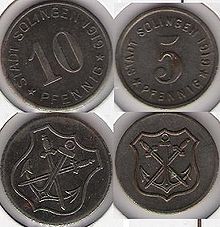

In 1815 the Bergisches Land fell to Prussia ; Solingen was raised to a district town. According to the Prussian town order , the former municipalities of Burg, Dorp, Gräfrath, Höhscheid, Merscheid and Wald received town rights in 1856. On August 11, 1891, the city of Merscheid was renamed Ohligs. In 1896 Solingen became an independent city. The Müngstener Brücke was inaugurated a year later, and since then it has been Germany's highest railway bridge at 107 meters. The First World War from 1914 to 1918 hit the export-oriented Solingen cutlery industry particularly hard because the sales markets abroad collapsed. The cities of Gräfrath, Höhscheid, Ohligs, Wald and Solingen were united on August 1, 1929 by the law on municipal reorganization to form the new city of Solingen.
After Adolf Hitler came to power and was appointed the new Reich Chancellor , violent clashes broke out between Communists and National Socialists in Solingen-Ohligs on February 7, 1933. The first so-called protective prisoners were imprisoned in the Solingen police prison and in the Ohligs district court. The SPD mayor Josef Brisch was briefly imprisoned in March 1933 and dismissed from office without notice on August 20, 1933. The NSDAP district leader for Solingen, Helmut Otto , became the new mayor of the city of blades on April 3, 1933 . In 1938 the law for the protection of the name Solingen was passed, which placed the brand name "Solingen" for cutlery from Solingen under protection. On March 3, 1943, 62 Solingen citizens who belonged to the Sinti population group were deported to the Auschwitz extermination camp from the two urban so-called Gypsy camps at Potshauser Strasse 10 and Wörthstrasse 24. About half of them were still children at the time. At least 55 of them were murdered.
On April 13, 1945, three days before the Americans marched into Ohligs, a killing squad consisting of the Gestapo and SS murdered 71 men from Remscheid and Wuppertal (not from Solingen) at Wenzelnberg in Langenfeld-Wiescheid . According to official information, the men were tied up there in pairs and shot in the neck . Locals also spoke of unshot men who fell tied up in the pit and were buried alive. The commanding officer and head of the firing squad was the then lawyer and SS-Hauptsturmführer Theodor Goeke (reported missing or declared dead since 1945) at the end of April 1945 American soldiers had the bodies exhumed and on May 1, 1945 on the square in front of the Ohligser Burial town hall. The population was obliged to take part in the funeral service, around 3000 people took part in the funeral service when specifically requested. During the Second World War , the medieval old town of Solingen was completely destroyed by the air raids on Solingen in November 1944 . American soldiers marched into Solingen on April 17, 1945. In total, over 5,000 Solingen citizens died in World War II (1939 to 1945) as a result of acts of war and / or the Nazi dictatorship. It was not until 1965 that the corpses were exhumed again and buried again at Wenzelnberg, where a memorial has been located ever since.
From 1945 to 1949 Solingen was part of the British zone of occupation . In 1993, Solingen hit the headlines around the world due to a right-wing extremist arson attack in which five Turkish girls and women were killed (see Solingen assassination attempt ). As a reaction to the attack, demonstrations and riots broke out in the city in the days that followed.
City name
The origin and meaning of the city name are partly disputed. Due to the constantly changing spelling over the centuries, there are different interpretations. The meaning of the first part of the word Sol- , which indicates a damp or swampy area, is undisputed . This derivation is possible from the term pillars , which describes the nature of the earth as muddy and muddy. In the Alemannic area (today's southwest of Germany, reaching as far as Switzerland), the final syllable -ingen is firmly ascribed to the old Germanic tribes.
The city name has (probably) developed over the centuries from Solagon to today's spelling Solingen as follows:
- Solagon (965) - Solonchon (1067) - Solingin (1224) - Solingen (1374)
Demographics
Population development
| year | Residents |
|---|---|
| 1949 | 146.162 |
| 1954 | 157.430 |
| 1959 | 167.036 |
| 1964 | 173,900 |
| 1969 | 177.087 |
| 1974 | 174.995 |
| 1979 | 169.875 |
| 1984 | 162,574 |
| 1989 | 162.096 |
| 1994 | 165.404 |
| 1999 | 164,676 |
| 2004 | 163.156 |
| 2009 | 160.992 |
| 2014 | 156.369 |
| December 31, 2019 | 163.112 |
Solingen's population rose only very slowly from the Middle Ages to industrialization . It was only industrialization and the associated urbanization effect that ensured that the number of inhabitants in the cities of Central Europe rose rapidly, including in Solingen. Today's city of Solingen is the result of several amalgamations of neighboring communities over many decades. The original core town of Solingen (today Solingen-Mitte) received city rights as early as 1374 . In 1896 Solingen became an independent city . In 1910, the then medium- sized town of Solingen already had more than 50,000 inhabitants, in particular the labor requirements of the metal processing companies were responsible for the population growth in the city of blades.
In 1929 Solingen became a large city due to the law on the municipal reorganization of the Rhenish-Westphalian industrial area . By the then politically wanted merger, the cities of Ohligs (29,768 inhabitants), Wald (27,443 inhabitants), Höhscheid (15,854 inhabitants), Gräfrath (10,582 inhabitants) and Solingen (56,353 inhabitants) were united to form the new city of Solingen. The town union took place officially on August 1st, 1929. At that time Solingen had about 140,000 inhabitants. In the post-war years, the population continued to grow vigorously. In 1972 it reached its historical high with 177,899 inhabitants.
Population forecast until 2040
The population of Solingen has been growing since 2014 and stood at 163,112 on December 31, 2019.
The population growth since 2014 is explained by the immigration of new citizens, which means: The immigration to Solingen exceeds the number of immigrants and deaths in Solingen. In addition, the city of blades is getting younger and younger due to immigration from outside. New citizens are on average 32.0 years old, while the Solingen native population has an average age of 44.1 years. Since the beginning of the 2010s there has been a strong influx of young families from the Düsseldorf area (especially from Haan and Hilden). According to the Solingen city administration, the number of inhabitants in Solingen will remain stable over the next few years. According to a prognosis, more than 164,000 people will live in Solingen in 2040. All figures are based on current data from the Solingen population register. The software used has established itself as a standard program especially for municipalities. This database is more precise and has proven to be more reliable than that of the IT.NRW state office , which approx. 4,000 fewer inhabitants.
“We are a growing city. Around 1,000 new citizens move to Solingen every year. "
Share of the population with German citizenship
In Solingen there are 106,658 German residents who do not have a migration background, this group of people has at least the second generation of German citizenship . The size corresponds to 65.0% of the total population of Solingen (as of June 30, 2017). You have a migration background in Germany if you are not a German citizen yourself or if at least one parent is not a German citizen (definition according to the Federal Statistical Office ).
Migrant statistics
People from 140 nations live in the city of blades. The proportion of migrants in Solingen is growing and currently amounts to 35.0% of the total number of residents. The quota of foreigners in Solingen is higher than the national average. On December 31, 2019, a total of 27,575 people in Solingen did not have German citizenship. In 2019, over 30,000 people from Solingen had dual citizenship.
The three largest groups of migrants in Solingen are:
- Italian (5,980)
- Turks (5,885)
- Syrians (1,830)
It is noticeable that the proportion of migrants in the city of blades increases the younger the people are. According to a data analysis by IT.NRW , the proportion of migrants in the group of over 75-year-olds is 11%, in the group of under 3-year-olds it is 56% (and rising). In figures, this means that the proportion of migrants will increase, while Solingen citizens without an immigrant background are becoming fewer and fewer. For the year 2040, the statisticians estimate that the number of migrants is expected to increase by around 8,300. Every second newborn child in Solingen today has a migration background (as of June 30, 2017).
Seniors statistics
In 2019, a data collection for Solingen (created by the statics office IT.NRW) showed that the proportion of senior citizens in the city of blades will increase significantly. According to this, over 44,000 Solingen citizens will be at least 65 years or older in 2040. This means that this population group is growing by 32% compared to 2019. In the group up to 65 years of age, Solingen will shrink by at least 6,000 people.
Refugee statistics
Currently (2020) around 3300 people with refugee status live in Solingen. According to the city administration, around 2,800 of them live in private apartments and around 500 in public accommodation. Of all refugees, more than 2,400 have a valid residence permit after the asylum procedure has been completed, for over 400 refugees the asylum procedure is still ongoing or they are temporarily tolerated. In 2018 there were 38 voluntary departures and 58 forced deportations.
Religions
Denomination statistics
According to the 2011 census , 32.3% of the residents were Protestant , 26.0% Roman Catholic and 41.7% were non-denominational , belonged to another religious community or did not provide any information. The number of Catholics, and especially Protestants, has fallen since then. On December 31, 2019, 26.6% of the 163,112 inhabitants were Protestant and 24.9% Roman Catholic. 48.5% of the citizens of Solingen are non-denominational or belong to another religious community.
Christianity
Catholics
Since the Christianization of the areas on the right bank of the Rhine, the greater Solingen area has always been under the rule of the Archdiocese of Cologne . All Catholic priests in the city of blades are subordinate to the incumbent Archbishop of Cologne and are bound by instructions . The verifiably first church in Solingen, probably a simple wooden church, must have already existed around the year 1000 in what is now the Wald district. Although the Reformation found its way into Solingen under the Counts of Berg , there were still Catholics in the Klingentadt. In 1827 Solingen became the seat of a deanery as part of the Archdiocese of Cologne. Today there are three large Catholic parishes in Solingen: St. Sebastian, St. Clemens and St. John the Baptist.
Lutheran
The Reformation only slowly gained a foothold in Solingen. Around 1635, the first Lutheran members of the faith formed a community in Solingen. In 1649 the former Catholic parish church in Solingen was handed over to the Reformed. In 1838 the uniate evangelical community was formed in Solingen. While the Protestant parishioners of Solingen initially belonged to the Lennep District Synod (today a district of Remscheid ), a synod was established in Solingen in 1843 and the city was the seat of a superintendent . This resulted in today's church district Solingen within the Evangelical Church in the Rhineland , to which most of the Protestant parishes of Solingen belong, provided that they are not free churches . Only the community in Solingen-Burg does not belong to the church district of Solingen. Today there are ten Protestant parishes in the city, three Catholic parish associations and one Greek Orthodox church. There are also several Evangelical Free Churches ( Baptist and Brethren congregations ), a Methodist Church , the Seventh-day Adventist Church , the Reform Adventists , a Christian Ecclesia congregation , several Free Evangelical Congregations (FeG) and the Salvation Army in the city of blades resident.
Jehovah's Witnesses are represented in the Solingen city area with three German-speaking assemblies (North, Middle, Ohligs). There is also an Italian and a Russian assembly. Meetings are held in two Kingdom Halls in Forest and Central. Other Christian religious communities in Solingen are the Church of Jesus Christ of Latter-day Saints and the New Apostolic Church .
St. Reinoldi Chapel in Rupelrath
Luther Church in the city center
Islam
According to the Solingen city administration, around 5,500 Muslims live in Solingen (2019 estimate). There are no official statistics in Solingen, as is the case with the Protestant and Catholic Churches. The actual number of fellow Muslim citizens is likely higher for Blade City.
There are currently eight mosques in Solingen :
- DITIB Solingen-Mitte (Kasernenstrasse 31)
- DITIB Solingen-Wald (Heukämpchenstrasse 5)
- Solingen Camii (Konrad-Adenauer-Straße 22)
- Selimiye Camii (Hallway 27)
- Mesjid An Nour (Florastraße 14b)
- Ohligs Süleymaniye Mosche (Querstraße 9)
- Islamic Cultural Center (Klauberger Str. 1)
- Milli Görüs Islamic Congregation (19a Van Meenen Street)
There has been no public Salafist scene in Solingen since 2012.
Judaism


The first Jewish families probably moved to Solingen as early as the middle of the 16th century. At first they mostly worked as small traders or as butchers . There was a Jewish community in Solingen as early as 1708. A Jewish cemetery (which still exists today) was built around 1718. A prayer hall with a mikveh have used Solinger Jews in 1780 at the corner Ufergarten / island in the Solingen city center. From the 19th century, due to the economic boom in the city, the number of Jews in Solingen also grew rapidly. A synagogue community was officially founded in 1853, in the following years the construction of the first Solingen synagogue was planned, which was finally realized on Malteserstrasse in the city center and inaugurated on March 8, 1872.
When Adolf Hitler came to power in 1933, there were 217 believing Jews in Solingen. The Solingen synagogue on Malteserstraße was set on fire , like many others in the German Reich at that time, during the Reichspogromnacht from November 9th to 10th, 1938 and completely destroyed. It was never rebuilt. In the years 1941 and 1942, there were deportations of Solingen Jews in concentration camps of the Nazis . In November 1944, the Solingen Jews living in mixed marriages were abducted and deported to the Theresienstadt concentration camp. Stolpersteine in numerous places in the city are reminiscent of former Jewish residents. For other victims of the National Socialists, including many Jews, see the list of Nazi victims from Solingen .
After the end of the Second World War, some of the surviving Jews from Solingen returned to their hometown, including the doctor and writer Emil Kronenberg . Many more found their new home in Solingen after the collapse of the Soviet Union in the early 1990s. In 2002 the city of Solingen, together with Remscheid , Velbert and Wuppertal, participated in the construction of the new Bergische Synagogue in Wuppertal. The number of Jews living in Solingen today was estimated at around 200 in 2010.
Max Leven Center in Solingen-Mitte (from 2023)
In 2023, the new head office of the Solinger Sparkasse is to open on the property between Max-Leven-Gasse and Peter-Knecht-Straße in downtown Solingen. The 150 m² Max Leven Center will be integrated into the future Sparkasse headquarters. The Max Leven Center is intended to commemorate the Nazi victim Max Leven (1882–1938) and serve as an educational institution. Visitors to the Max Leven Center are to be informed about the various aspects of persecution and resistance in Solingen during the National Socialist era .
Politics and City Administration
The citizens of the city of Solingen have been able to elect a council and a mayor since 1374, the year when city rights were obtained . The mayor changed annually on June 24th. Is one since 1896 in the city of Solingen tip mayor , who during the time of National Socialism (1933 through 1945) of the NSDAP was used and was not elected in a democratic election of Solingen citizens.
After the Second World War , the military government of the British zone of occupation appointed a Lord Mayor. From 1946 onwards, the Solingen council elected an honorary mayor and a full-time senior city director from among its members . The honorary mayors took on mainly representative tasks until 1997, while the full-time senior city directors, as the highest city administrative officials, headed the Solingen city administration.
City directors 1946–1997
- 1946–1963: Gerhard Berting
- 1964–1976: Willi Fischer
- 1976–1981: Friedhelm Schmitz-Herscheid, CDU
- 1981–1991: Peter Hölz , CDU
- 1991–1997: Ingolf Deubel , SPD
Mayor and Lord Mayor since 1800
|
|
Directly elected mayor since 1999
In 1997 the dual leadership in the NRW city administrations was abolished. Since then there has only been the full-time mayor. He is the chairman of the council, head of the city administration and first representative of the city. Since 1999 he has been elected directly by the citizens entitled to vote in a secret ballot.
Mayor election 2015
In the runoff election on September 27, 2015, Tim Kurzbach (SPD) won the election as the new mayor with 55.61% of the vote. His opponent from the Solingen CDU was Frank Feller, who received 44.39% of the vote. The turnout was 33.3%. Kurzbach has been the acting Lord Mayor since October 21, 2015 and was sworn in as the new Lord Mayor on October 29, 2015 in a special meeting of the Solingen City Council in the Ohlig festival hall. Tim Kurzbach's term of office ends in October 2020.
Solingen local elections 2020
The next Solingen local election will take place on Sunday, September 13th, 2020. In addition to the city council and the five district councils, the mayor is also elected. There are only male candidates from the parties in the city of blades for the mayoral election in September. It refers to:
- Tim Kurzbach, for the SPD and the Greens
- Carsten Becker, CDU
- Jan Michael Lange, BfS
- Raoul Brattig, FDP
- Adrian Scheffels, left
- Andreas Lukisch, AfD
For the local elections, the constituencies have been redesigned: It is no longer the number of inhabitants in the respective constituencies that is decisive, but the number of EU citizens actually entitled to vote. If none of the six applicants receives more than half of the valid votes in the first ballot (at least 50.01%), a runoff election will take place on September 27, 2020. The new electoral term begins on November 1, 2020 and ends on October 31, 2025.
Administrative director of the city of Solingen
The mayor and the elected councilors together form the administrative board. The councilors are local electoral officials and are elected by the city council for a period of eight years. The rights and duties of the administrative board are laid down in the Solingen municipal code (Section 70). The administrative board usually meets weekly under the chairmanship of the mayor, who has a veto right .
The committee is responsible for basic communal matters of the city of Solingen in the following areas:
- Establishing the budget
- Financial control over city spending
- Administrative decisions of particular importance for the city of Solingen
- Personnel management of the city's executives (in particular the respective heads of department and managing directors of the city's subsidiaries)
| Department 1: Administrative control | Lord Mayor Tim Kurzbach ( SPD ), in office since 2015 |
| Department 2: Finances, building and property management, investments | Alderman and city treasurer Ralf Weeke ( SPD ), in office since 2001 |
| Department 3: Citizen Service, Law, Order and Social Affairs | Alderman Jan Welzel ( CDU ), in office since 2015 |
| Department 4: Youth, School, Integration, Culture and Sport | Alderman Dagmar Becker ( Greens ), in office since 2015 |
| Department 5: Planning, Construction, Transport and Environment | Alderman and City Director (general representative of the Lord Mayor) Hartmut Hoferichter (independent), in office since 2001 |
Honorary Mayor
- 2014 – today: Ernst Lauterjung, SPD (first honorary deputy to the Lord Mayor)
- 2014 – today: Carsten Voigt, CDU (second honorary deputy to the mayor)
The honorary mayors are only elected by the members of the Solingen city council. You perform representative tasks for the city of Solingen and have no power of attorney.
City Council
Solingen City Council 2019
The Solingen city council was elected on May 25, 2014 and has a total of 53 seats. The current legislative period ends on September 13, 2020. Ten different parties or groups are currently represented in the Solingen city council. Political decisions and resolutions are made in the City Council of Solingen with changing majorities. There has been no clear division into government parties and opposition since the local elections in May 2014. For a majority, at least 27 votes must be organized. There is no fixed coalition or cooperation between the parliamentary groups in the Solingen city council. A large majority from the CDU, SPD, Greens, FDP and the BfS was found for the budget decisions of recent years. As the largest parliamentary group, the CDU has 17 council members. The SPD has 15 mandates. It follows: Greens (6 seats), BfS (4), FDP (3), Left Party (3). Further members of the city council are the Free Citizens Union (1) and Solingen-Aktiv (1). There are also two non-party council members.
The currently incumbent Lord Mayor has one vote in the council, but no seat, according to the municipal code. As a non-attached council member , he chairs the city council meetings.
The seats of the individual parties have been distributed as follows since May 25, 2014:
| Electoral term | CDU | SPD | Green | BfS 1 | FDP | The left | Solingen active | Free Citizens Union | independent (Schlupp and Hövels) | total |
| 2014-2020 | 17th | 15th | 6th | 4th | 3 | 3 | 1 | 1 | 2 | 52 |
District offices
Each of the five city districts has a district representative, which in the case of the two smaller districts of Gräfrath and Wald consists of 13, otherwise of 15 members. The members of this representation are called district representatives , the chairman of a district representation is the district mayor . The district representatives are responsible for certain tasks of the district and have the right to be heard on all relevant matters in the district. For example, they take care of matters relating to road traffic , the school system and the maintenance of the townscape in their district and act as a local interface between the council, the city administration and the citizens.
The Solingen district councils were elected on May 25, 2014 by those eligible to vote in the city district. The current legislative periods for the district representatives end on September 13, 2020.
The five district mayors:
- Burg / Höhscheid : Axel Birkenbeul ( SPD )
- Gräfrath : Udo Vogtländer (SPD)
- Solingen-Mitte : Richard Schmidt (SPD)
- Ohligs / Aufderhöhe / Merscheid : Marc Westkämper ( CDU )
- Forest : Birgit Zeier (SPD)
Youth Councilor
In addition to the city council, the city has a youth representative body. The youth city council consists of 21 youth city councilors and is elected every two years by young people between the ages of 14 and 18 years. It should take up problems of the youth and contribute to their solution. With the help of the city council, the youth city council succeeded, for example, in realizing the Rollhaus skater hall , developing an integration program for migrants, setting up a night express line to the former Getaway disco and establishing a youth culture festival. For some years now, the newly added projects have also included the development of the South Park, which is popular with young people .
From May 18 to 22, 2015, the current tenth youth councilor was elected at the Solingen schools.
Debt level
Solingen currently (2020) has total debts of at least 1 billion euros (long-term liabilities, short-term cash loans , securities debts and investment loans together). The city of blades has been trying for years to balance the budget with NRW financial allocations. The cash advances add up to approx. 518 million euros. The liabilities through investment loans are around 200 million euros and the Technischen Betriebe Solingen (TBS) are currently in debt with 260 million euros.
For the budget year 2020, an annual deficit of at least 50 million euros is expected due to the corona crisis , in particular, a shortfall in income for trade tax, as well as income and sales tax is forecast.
Solingen's financial situation is significantly worse than that of many other large cities in Germany. Various austerity measures have so far been unsuccessful. The indebtedness of the city of blades joined in 2014, that balance sheet equity of Solingen has since run out. In 2017, the per capita debt in Solingen was 6,624 euros per inhabitant. The debt ratio of the total population of Solingen was 15.3% in 2019, higher than the NRW state average (11.7%). This is the result of Creditreform Solingen .
Coat of arms and seal
Probably the oldest known city seal is attached to an Altenberg document from 1468. It shows the city's patron saint , Saint Clement , who has presumably been the city's patron saint since the 10th century. In his honor, the Catholic town church and its predecessor buildings have borne his name for centuries, and since 1974 a memorial in front of the church by the local artist Hendryk Dywan commemorates the saint. According to legend, he was martyred by drowning with the help of an anchor . This anchor was used as an attribute for Clemens on an early city coat of arms from 1630 .
After the unification of cities in 1929, the city coat of arms was given a five-tower wall crown , which classifies Solingen as a large city and does not - as is often wrongly assumed - stand for the five cities from which today's Solingen was formed. On July 17, 1935, the city of Solingen officially received the right to carry a new city coat of arms, plus two crossed swords with golden hilts , which should emphasize the importance of the city of blades as the place of origin of high-quality cutlery. The design comes from the painter and heraldist Wolfgang Pagenstecher .
| Blazon : “In blue a golden anchor, two silver, diagonally crossed, overturned swords with golden hilts covered and crossed with the tips. On the upper edge of the shield a golden wall crown with five tin towers, each with a passage and two battlements. " | |
Town twinning
Solingen took over after World War II, a sponsorship for the following community:
|
|
Złotoryja (Goldberg) in Poland since 1955 |
The city also maintains city partnerships with the following cities:
|
|
Gouda in the Netherlands since 1957 |
|
|
Chalon-sur-Saône in France since 1960 |
|
|
Blyth in the UK since 1962 |
|
|
Nes Ziona in Israel since 1986 |
|
|
Aue in Saxony since 1990 |
|
|
Thiès in Senegal since 2016 |
|
|
Jinotega in Nicaragua since 2016 |
economy
Since the Middle Ages Solingen, recognizable by the nickname City of Blades, the heart of the European cutlery industry . Around 90 percent of the German cutlery and cutlery industry is based in Solingen. In Solingen it makes up an important branch of the economy with a 21 percent share of total sales in the manufacturing industry. The Industry Association for Cutting and Household Goods e. V. is based in Solingen.
In the course of the decades, however, other branches of the economy have been added, above all automotive supply and electroplating . Around 150 companies in Solingen belong to the electroplating industry, making the city an important location for the industry nationwide. In addition, the Institute for Electroplating and Surface Technology (IGOS) has been located in the city since 1993. Its services include advice and training, layer and damage analysis and corrosion tests. The largest representatives of the automotive supplier industry in Solingen are, for example, the companies Accuride (formerly Kronprinz) or BIA Kunststoff- und Galvanotechnik. The latter is now the city's largest private employer. The second largest wet shave manufacturer after Gillette, Wilkinson Sword , maintains a plant or the German headquarters in Solingen; the largest German Haribo plant is also located in the city . The city of Solingen also maintains a start-up and technology center , which has been located on the factory premises of the cutlery company Friedrich Herder Abraham Sohn in Solingen-Höhscheid since 1998 . It provides support in the form of advice and further training for founders in Solingen. The historic steam engine hall serves as a backdrop for the ARD format Knowledge before eight .
In 2016 Solingen generated a gross domestic product (GDP) of € 4.967 billion. In the same year, GDP per capita was € 31,277 (North Rhine-Westphalia: € 37,416 / Germany € 38,180) and thus below the regional and national average. In 2016 there were around 72,400 gainfully employed people in the city. The unemployment rate in December 2019 was 6.8% and thus slightly above the average for North Rhine-Westphalia of 6.4%.
Blade manufacture

The manufacture of weapons , mainly swords, began early in Solingen: The first documentary evidence of blade manufacture dates back to 1363. The two main reasons for the settlement of the blade manufacturers were, on the one hand, the abundant streams and rivers that provide the decisive energy and, on the other hand, the proximity to the then already well-known trading city of Cologne . In 1401, the hardeners and grinders in Solingen were given the privilege of forming a guild . In the 16th century there was a large influx of knife makers in the city; this century, together with the following century, is considered the high point of blade manufacture in Solingen. "... me fecit Solingen" (Eng. "... Solingen made me") as a marking on swords has become a synonym for high-quality blades throughout Central Europe. The Solingen swords were in demand with almost all ruling houses in this region and their quality was valued.
In the course of time, other branches of production were added. The knife makers 'guild was founded in 1571, followed by the scissors' guild a little later. The manufacture of the blades for these purposes was divided into the grinders, who possibly worked together to 100 people in their cottages on the Solingen brooks, and the hardeners and the Reider , who lived and worked together on the ridges of the city in the so-called court associations . Until the middle of the 19th century, the cutlery industry determined the entire Solingen economy. It was not until the First World War that the continuous upswing in blade manufacture came to an end, as there were no sales markets because the Solingen industry was cut off from the world market. In addition, unemployment and military service also had a negative impact on the economy. In 1938 the government passed a law to protect the name of Solingen .
In the post-war period, mechanization in the Solingen cutlery production ensured increasing productivity. However, between 1959 and 1989 production fell by about half. In 1994 the law for the protection of the name Solingen passed in 1938 was repealed and was replaced by the comparable Solingen Ordinance. Since the second half of the twentieth century, razor blades have been manufactured in hundreds of small businesses in Solingen . Today, large market shares have been lost to international companies, above all to Wilkinson Sword , which has its German headquarters in Solingen.
Since the middle of September 2012, the city has been officially advertising on its entrance signs with the addition of Klingenstadt . In this way, tourists should be made aware of the importance of Solingen as the center of the German cutlery industry. This tradition is not only cultivated on the town signs, but also through museums in various parts of the city: German Blade Museum in Gräfrath, Balkhauser Kotten and Wipperkotten in Höhscheid, as well as Loos'n Maschinn in Widdert and the LVR industrial museum , the Hendrichs drop forge in Merscheid .
Company in Solingen
Traditionally there was no separation between residential and industrial areas in Solingen for a long time, so that even today many industrial companies can still be found in the middle of residential areas. It was not until the 20th century that Solingen began to designate larger areas outside of residential development for trade and industry . Due to globalization , large industrial companies with more than a thousand employees are now the absolute exception in the city of blades. Most of those companies experienced their decline or drastically reduced their number of employees at the end of the 1990s (see also the sub-item Former Companies ). The industrial structural change in Solingen from a traditional metalworking city in the Bergisches Land to a digital service location on the Rhine is only going slowly. Since the turn of the millennium, pure service companies have become more and more important in the Solingen economy.
The following table only shows the larger Solingen companies that have at least 100 employees. The numerous small family businesses that have been based in Solingen for decades and have fewer than 100 employees remain unnamed , but are nevertheless of major importance for the Solingen economy.
They are listed in alphabetical order, name additions or legal forms have generally been omitted for the sake of clarity:

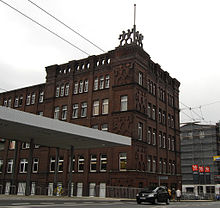


| Companies | Branch | Number of employees (rounded) |
|---|---|---|
| Accuride | Automotive supplier | 500 |
| Adient | Automotive supplier | 220 |
| Workers Welfare Association Solingen | Workers welfare | 150 |
| Bergische health insurance | Health insurance | 130 |
| BIA plastic and electroplating technology | Automotive supplier | 1,040 |
| Bong | envelopes | 200 |
| Borbet | Automotive supplier | 600 |
| Brangs + Heinrich | packagings | 170 |
| BSS Bohnenberg GmbH | Logistics outfitter | 120 |
| CCL design | Automotive supplier | 150 |
| codecentric AG | Software developer | 400 |
| Diaconal work Bethanien | Medical supplies | 1,000 |
| Forest technology | Broaching technology | 130 |
| General Electric Healthcare | Medical technology | 400 |
| Haribo | confectionery | 900 |
| IPS industrial and personnel service | Personnel services | 200 |
| item industrial technology | Industrial technology | 200 |
| JC King | Deep-drawn parts | 170 |
| Junker factory Linder | Foam processing | 200 |
| KTS | Automotive supplier | 200 |
| Lebenshilfe local association Solingen | Workshops for the disabled | 720 |
| LUTZ blades | Cutlery | 250 |
| Martor | Cutlery | 140 |
| MC Donalds | Fast food restaurant | 150 |
| City administration of Solingen | public service | 2,400 |
| City-Sparkasse Solingen | Savings bank | 552 |
| Solingen municipal utilities | public service | 650 |
| Municipal Clinic Solingen | Medical supplies | 1,600 |
| Saint Luke Clinic | Medical supplies | 700 |
| Technical operations Solingen | public service | 480 |
| United Salon Technologies | Cutlery | 230 |
| VS cast | Automotive supplier | 185 |
| Whale bush | Fashion | 730 |
| WebID Solutions | Financial technology | 450 |
| Wilkinson Sword | Cutlery | 650 |
| Wusthof | Cutlery | 340 |
| Zwilling JA Henckels | Cutlery | 500 |
Formerly important companies
Many companies, some of them world-famous, were founded in Solingen:
- With Rasspe , one of the world's largest manufacturers of agricultural machine parts had its headquarters in Solingen for a long time . At the end of the 20th century the decline came and the workforce was drastically reduced. A little later, the company headquarters were relocated to neighboring Wermelskirchen . The area of the company am Stöcken in Solingen-Mitte is now the largest fallow industrial area in the city.
- The Rheinische Tür closerfabrik was founded in 1903 by Adolf Boge and Fritz Kasten in Solingen. The company became the European market leader for door locks and after the merger, with other industrial companies, relocated its headquarters to Velbert . The former Rhenish door closer factory is now the market leader for door locks in Germany as BKS GmbH .
- The Bremshey company in Ohlig was also one of the city's most important companies. With her most famous product, the collapsible umbrella , which has become known under the brand name Knirps , she achieved worldwide fame. In the early 1970s, the company had around 3,000 employees. After financial bottlenecks at the beginning of the 1980s, the company initially drastically reduced its workforce before it was completely dissolved in 1982.
- It was a similar story for the household goods giant Krups , which flourished in the 1970s. At times the company in Solingen-Wald employed over 3,000 people. Since the bankruptcy of the parent company Moulinex in 2001, the decline followed for Krups in Solingen; all production facilities in Solingen-Wald were demolished. Today's household appliances that are available under the Krups brand name are produced by the French Groupe SEB and have no relation to Solingen.
Retail locations
Solingen-Ohligs
Düsseldorfer Straße in the Ohligs district is the longest connected shopping street in Solingen. The approximately 1 km long shopping mile that goes from the main train station to Ohligser Marktplatz is predominantly characterized by owner-managed retail stores. As a pure pedestrian zone , Düsseldorfer Straße is now the largest retail location in the west of Solingen and is also known as Dü for short in Ohligs . Today the restored house facades form a historical ensemble from the Wilhelminian era (1870–1914) .
By spring 2022, Düsseldorfer Straße will be modernized based on the ideas of a planning competition. The Ohligser shopping mile will u. a. newly paved with a light concrete block and water-permeable joints , the current tree population is renewed and adapted to the local conditions, at night the Düsseldorfer Straße is to be re-lit with energy-saving LED street lighting. The Solingen city administration is investing approx. 4.8 million euros in the modernization of the Dü . The city's own contribution to the modernization measure amounts to 600,000 euros. In addition, Düsseldorfer Straße is always the main venue of Solingen's largest folk festival, the Ohligser Dürpelfest, in May.
Solingen center

Most of the retail stores in Solingen-Mitte can be found between the intersections at Schlagbaum and the Werwolf . The largest shopping center in the city of blades, the Hofgarten Solingen, is located here .
Solingen forest
Solingen's smallest pedestrian zone is in the center of the Wald district ; she is also the youngest. It essentially extends along the Walder Rundling. The Walder Rundling is the center of the Solingen district of Wald, it is located directly at the Wald Evangelical Church.
Solingen weekly markets
In addition, three weekly markets that take place regularly enliven community life in the Solingen districts. The local food supply is provided by the weekly markets at the following locations: In Ohligs on the market square; at the Neumarkt in Solingen-Mitte and on the market square in Solingen-Wald. All three Solingen weekly markets are operated by the Solingen weekly markets UG. In the past, for example, there was a pretzel day in Ohligs, an Oktoberfest in Wald and a jazz breakfast in Mitte at the Solingen weekly markets.
traffic
Central Station
Solingen's largest and most important train station is located in Ohligs: Solingen Central Station . From Ohligs is:
- the Cologne Main Station in about 40 minutes;
- the Düsseldorf main station in about 30 minutes;
- of Remscheid main station in about 25 minutes;
- the Wuppertal main station can be reached in about 20 minutes.
The main station is the only station in Solingen that is connected to the long-distance network of Deutsche Bahn AG . With Intercity Express , Intercity , Regional Express , Regionalbahn and S-Bahn , all important types of train are available. The Solingen main station can be reached on the front above the station forecourt, which is directly adjacent to the upper Düsseldorfer Straße. A 6,000 m² hotel for the Ohligs district will be built on the back of Solingen's main train station by autumn 2022. The new hotel, which will have over 150 rooms, is to be built for around € 20,000,000. A 400 m² restaurant with outdoor seating is planned on the ground floor, which can also be used as a non-hotel guest. The special feature: the new hotel building means that in future there will be direct access to the back of Solingen's main train station from Steinstraße. The main station, which is used by over 10,000 passengers every day, is the most frequented traffic junction in Solingen.
In Solingen there are also the stops Solingen Grünewald , Solingen Mitte , Solingen Schaberg and Solingen Vogelpark .
Bus station at the main train station
The largest bus station in Solingen is the Ohligser bus station, it is located directly at the main station. Many Solingen bus routes and two trolleybus routes (ring lines 681 and 682) connect Ohligs with almost all parts of Solingen. The cities of Haan , Hilden , Langenfeld , Monheim am Rhein and Düsseldorf can also be reached from the bus station by bus from Stadtwerke Solingen or the Düsseldorf Rheinbahn . In addition to the bus station in Ohligs, the bus station in the city center at Graf-Wilhelm-Platz is a second traffic junction in Solingen.
Trolleybuses (since 1952)
After the Second World War , the city council decided to stop the Solingen tram and switch to trolleybuses. The main reasons for this decision were the low operating costs and the long service life of trolleybuses compared to conventionally operated buses with diesel engines. On June 19, 1952, the first trolleybus in Solingen ran on the route between Graf-Wilhelm-Platz and Ohligser bus station. Today, the city of blades has one of the largest trolleybus systems in Europe. It includes the six diameter lines 681 to 686 with a total route length of 56.6 kilometers. The Stadtwerke Solingen currently (2020) have over 50 operational articulated trolleybuses:
- 15 of the Dutch company Berkhof (built in 2001/02)
- 20 from the Belgian company Van Hool (built in 2002/03)
- 15 of the Swiss company Hess (year of construction 2008/09)
The trolleybuses serve the entire Solingen city area up to the city limits. The longest line, the 683, connects the Wuppertal-Vohwinkel train station with the Burg district of Solingen .
Battery trolley buses (since 2018)
The Stadtwerke have been testing four so-called battery overhead line buses (BOB) from Solaris and Kiepe Electric on the existing network since 2018 . The vehicles offer the possibility of converting lines that were previously operated by diesel buses to fully electric operation. The battery trolleybuses have a battery and pantograph so that the battery can be charged while driving on routes with the overhead line, so that they can continue to drive fully electrically away from the overhead line.
Another 16 buses of this model series have already been ordered and are to be delivered in spring 2020. The BOB project is a model nationwide and is publicly funded by the federal government with around 15 million euros. The battery trolleybuses can save 320,000 liters of diesel per year in the long term, which corresponds to approx. 726 tons of carbon dioxide. The municipal utilities in Solingen intend to do without diesel engines in buses by 2030.
Motorway connection
The Viehbachtalstrasse city motorway runs from Solingen-Mitte (Frankfurter Damm entrance) to Solingen-Ohligs (Bonner Strasse exit). The Viehbachtalstraße has no direct connection to the trunk road network and was implemented as a four-lane city motorway L 141n in Solingen's urban area. Since the 1970s, local politicians in Solingen have been arguing intensely about whether it makes sense to close the gap between the Bonner Strasse exit in Ohligs and the A3 motorway in Hilden's urban area, in order to enable a direct connection to the trunk road network. However, this (theoretical) extension of the Viehbachtalstrasse city motorway and a direct junction connected to it on Solingen's urban area has not been able to win a majority in Solingen's local politics for decades.
Solingen and Reutlingen are the only major cities in Germany that are not directly connected to the motorway network. The Solingen motorway junction on the A3 is located a few kilometers south of Ohligs in the area of the city of Langenfeld on the border with Solingen-Aufderhöhe. Solingen has been connected to the trunk road network with this junction since 1936. Other motorway connections - Haan-West and Haan-Ost on the A 46 and Wermelskirchen on the A 1 - are also only a little outside the city area. The motorway-like L 74 connects Solingen with the Sonnborner Kreuz (A 46 and A 535). The Hilden Cross with the Hilden junction is about eight kilometers to the northwest.
Bike paths
Due to the sometimes steep topography of the city, politics has for a long time not attached great importance to cycling . The post-war urban planning therefore focused on the expansion of traffic routes for motorized individual traffic . So let z. For example, the expansion of the central Schlagbaum junction in the north of the city in the 1970s completely left out plans for cycle paths. It was not until the turn of the millennium that a social rethinking took place, which attached greater importance to cycling and also left its mark on Solingen. In 1995, the Round Table for Bicycle Traffic was launched, which advises the city of Solingen on issues relating to bicycle traffic, draws attention to problems and z. B. contributes to the bicycle city map published by the city and the bicycle traffic concept.
Since then, the main focus has been on the conversion of former railway lines to cycle paths . An example of this is the corkscrew route implemented as part of the Regionale 2006 , which connects the Solingen Südpark with the districts of Wald and Gräfrath as well as the neighboring towns of Haan and Wuppertal-Vohwinkel without any significant incline . Another example is the mountain railway line, which, as a former section of the Barmer Bergbahn , connects the Solingen city center with Müngsten and the bridge park. This project also saw its implementation in the course of the Regionale. In addition, cycling is being given a higher priority in individual infrastructure projects of the present. However, this does not apply to the renovation of Konrad-Adenauer-Straße, in which bicycle traffic is to be routed via the less frequented main streets of the northern part of the city.
Hiking trails
What hinders cycling is good for hikers: the Wupper Mountains and the brook valleys are accessible through numerous hiking trails throughout the city. The best known and at the same time with nearly 70 kilometers the longest, extending to the entire urban area trail is the blade path , the path with the symbol S is marked. There are also various themed hiking trails, such as the Merscheider Scherenweg , around Merscheid or around the Sengbachtalsperre . There is also a forest damage nature trail around Burg and a geological nature trail along the 3.5 kilometer Willi-Lohbach-Weg. The Ohligser Heide, which in turn is accessible via hiking trails, is significantly flatter.
Castle cable car
In the district of Burg an der Wupper , an aerial cableway has been used since 1952 to overcome the around 90 meters in altitude between the districts of Ober- and Unterburg . The Burg cable car is mainly used for tourism, as it connects the historic district of Unterburg directly with the castle , but residents also use it as a means of inner-city transport.
Urban development
Regional 2006
The Regionale 2006 was a joint project of the cities of Remscheid, Solingen and Wuppertal supported by the state of North Rhine-Westphalia for the development of the Bergisch city triangle . As part of the Regionale, the three cities have been developing their own joint projects since 2001, which set urban, cultural and economic accents for structural change in the region. The aim was to profile the region and make it fit for the future. A large network of experts from politics, administration, science and institutions in the region was created for the work on the Regionale. Strong urban planning impulses for Solingen came from the region.
In 2006, at the end of the program at the Bergische Expo '06, the results of the cooperation as well as the services and qualities of the region were presented.
The following projects were carried out in Solingen:
- Graf-Wilhelm-Platz / Neumarkt - redesign of the central square ensemble in the city center with a new bus station
- Corkscrew route - conversion of the disused railway line Solingen-Mitte - Wuppertal into a cycle and hiking path through the city
- Südpark - creation of a new urban quarter with artist studios, apartments and restaurants on the site around the former main train station
- New inner-city train station Solingen Grünewald and new Solingen Mitte station on today's S-Bahn line Solingen-Remscheid-Wuppertal (S 7) as a replacement for the former main station, which despite its name was only an insignificant secondary station. Instead, the previous Solingen-Ohligs station was named Solingen Hauptbahnhof .
- Establishment of the product design forum in the old main station building with the Bergisches Institut for product development and innovation management , an institute affiliated to the Bergische Universität Wuppertal
- Renovation measures in the Kölner Strasse / Flurstrasse / Elisenstrasse area - including renovation of the Birkerbad bathing establishment , ice rink , use of former industrial buildings for the municipal music school
- Bridge Müngsten - landscaped park under the Müngstener bridge as a joint project of the three towns of Solingen, Remscheid and Wuppertal
City 2013
As part of the Solingen inner city concept City 2013 , the following sub-projects were implemented:
- Facade program - provision of public funds for the renovation of house facades in the inner, southern and northern part of the city
- Alter Markt / Kirchstrasse / Küstergasse / Linkgasse / Ohliger Tor - redesign of the central inner-city area around the Alter Markt with new paving and new design objects
- City church and Fronhof - renovation of the Protestant city church from 1956 and opening to the outside towards the Fronhof, making the Fronhof more attractive, setting up a church café in the city church, upgrading the building
- Entenpfuhl / Untere Hauptstraße - Redesign and upgrading of the square at Entenpfuhl including the entire lower main street, new design and new design objects
- Kölner Straße - redesign of the southern gate to the city center, upgrading of the street with new road surface and green strips
- Konrad-Adenauer Straße / Theater and Konzerthaus - redesign of the northern gate to the city center, upgrading of the street with new road surface, parking lots and green spaces, redesign and upgrading of the theater environment
In connection with the project was the construction of the Hofgarten shopping center on Graf-Wilhelm-Platz. The demolition of the old police station on Goerdelerstraße as well as the new building on Kölner Straße and the new building of the tax office at the same place on Goerdelerstraße were part of the far-reaching changes in the city center in addition to City 2013 .
media
Print media

The oldest Solingen daily newspaper, at the same time the one with the greatest circulation in the area, is the Solinger Tageblatt published by B. Boll ; Another daily newspaper is the Solinger Morgenpost , a local edition of the Rheinische Post . An offshoot of the Solinger Tageblatt is the weekly free advertising paper Das Solinger . In addition, the Solinger Wochenpost appears once a week . At the end of 2005 the Solinger Stadtanzeiger was published for the first time , which sees itself as an independent city magazine and appears once a month. The local culture magazine Engelbert is also published four times a year and has up to 40,000 readers per issue.
The street newspaper DIE STRASSE was published in the mid-1990s . Due to a lack of subsidies, the project had to cease operations at the end of May 2011. In the period that followed, media makers from Solingen tried to maintain the project through an overarching collaboration. This was achieved at the end of 2011 in the form of a cooperation with the Fifty-Fifty project.
Online media
SolingenMagazin has existed since autumn 2016 and covers current events and events in the city of blades as an online city blog or local online newspaper.
broadcast
The private radio station Radio RSG has been based in Solingen-Mitte since 1992 . As a local radio station and part of the Radio NRW media group , it broadcasts the latest news for Solingen and the neighboring city of Remscheid. Via the Solingen radio tower at the central, it broadcasts on the 94.3 MHz frequency for the entire Solingen city area. The frequencies 92.2 and 107.9 MHz are available for the neighboring city of Remscheid. The voluntary hospital radio "Studiowelle 2" has been broadcasting in the municipal hospital since 1978 .
Public facilities
Solingen is the seat of several public institutions and buildings. The Solingen District Court is one of the five subordinate courts to the Wuppertal Regional Court and is located not far from the Labor Court in downtown Solingen. The latter is responsible for legal disputes in Solingen and the neighboring town of Wermelskirchen . In addition, the Solingen Police Department of the Wuppertal Police Headquarters is located in the new office building on Kölner Straße, while the police stations are located in the city districts. There is an office of the Federal Employment Agency Solingen-Wuppertal in the district of Ohligs .
The Solingen professional fire brigade maintains three fire and rescue stations in the city: on Katternberg and in the districts of Ohligs and Wald. There are also eight fire fighting units from the volunteer fire brigade . The fire brigade control center operated jointly with the city of Wuppertal is located in the neighboring city.
The city operates three citizens' offices as branches of the city administration in the city center, the district of Höhscheid and Ohligs. A city library is located in the Clemens Galleries , also in the city center.
Other offices, offices and institutions are operated jointly within the framework of the cooperation between the three neighboring Bergisch cities , including the Bergisch Veterinary and Food Inspection Office based in Solingen, which is responsible for all cities in the Bergisch city triangle .
Medical supplies
There are three hospitals in Solingen for inpatient and outpatient basic medical care:
- Solingen Clinic (716 beds), Solingen-Wald
- Sankt Lukas Clinic (345 beds), Solingen-Ohligs
- Bethanien Hospital (120 beds), Solingen-Aufderhöhe
The Solingen Clinic is a maximum care hospital and has been an academic teaching hospital of the University of Cologne since 1977 . The clinic has 15 clinics, institutes and interdisciplinary centers managed by specialists. A new hospital was completed in 1962 on the upper Schwanenstrasse in Ohligs, the Catholic St. Lukas Clinic. The St. Lukas Clinic, which is located in the middle of the Ohligser Heide, has been continuously expanded and modernized since the 2000s . Today the clinic has a nationally renowned stroke center . The Sankt Lukas Clinic is currently operated by the Kplus Group . As a specialist clinic, the Bethanien Hospital has specialized in the diagnosis and treatment of all lung diseases and is used nationwide as a clinic for pneumology and allergology / center for sleep and respiratory medicine.
education
In the 2020/21 school year Solingen has:
- 3 vocational colleges
- 4 high schools
- 4 comprehensive schools
- 3 secondary schools
- 1 secondary school
- 3 special schools
- 21 elementary schools
Solingen is the first and currently (2020) only large city in North Rhine-Westphalia that does not have a secondary school.
The Central Technical School of the German Confectionery Industry in Gräfrath and the Walter Bremer Institute in the city center are also located in Solingen . As an academic teaching hospital at the University of Cologne since 1977, the Solingen Municipal Clinic should also be mentioned. In addition, Solingen maintains a municipal music school , which is located on the former Kieserling factory premises in the southern part of the city. The Bergische Volkshochschule is operated in intercommunal cooperation with the neighboring city of Wuppertal.
In the 2016/17 school year there were 22 special preparatory classes in Solingen for students with little or no knowledge of German.
Vocational colleges
Technical vocational college Solingen
The technical vocational college Solingen is located in Solingen-Mitte and was founded in 1823 as a Sunday school in the then city of Höhscheid. A new school building for the technical vocational college was inaugurated in 1904 and served as an economic instrument for employers in Solingen to improve the competitive situation with arch rivals Sheffield on the cutlery market. In the course of time, considerable cutlery and blade designs as well as flat designs have been created.
The vocational college is currently training state-certified industrial design and electroplating technicians. It has around 2,000 pupils who are trained in the forms of vocational school , vocational school and technical high school . From the secondary school diploma to the subject-specific university entrance qualification, all school diplomas recognized in North Rhine-Westphalia can be acquired or made up for later. The technical vocational college is also known nationwide as a training center for electroplaters and engravers . In addition, the inter-company training center for the painters and painters guild for Solingen and Remscheid is located on the property.
Friedrich List Vocational College
The Friedrich List Vocational College is a commercial vocational college with a focus on economics and administration. The school was founded in 1857 as a commercial vocational school and had its headquarters at various school locations in the Solingen city area. Since the school year 1958/59, the Friedrich List vocational college has been located in downtown Solingen at the Vorspel. It has more than 1,200 pupils who are trained in the school forms of vocational school , vocational school and business school. From the secondary school diploma to the general university entrance qualification, all school diplomas recognized in the state of North Rhine-Westphalia can be acquired or made up for later.
Since the school year 2009/10, the Walter-Bremer-Institut , a state-recognized educational institution for pharmaceutical-technical assistants , has also been located in the building of the Friedrich List Vocational College .
Mildred Scheel Vocational College
The Mildred Scheel Vocational College with a focus on social and health care is located in Solingen-Merscheid on Beethovenstrasse. The vocational college conveys various professional qualifications in a differentiated teaching system. In addition, all general educational qualifications can be acquired or made up for, from the secondary school diploma to the general university entrance qualification. The vocational college was named after Mildred Scheel , the wife of the former Federal President and native Solinger Walter Scheel , who distinguished herself through her social commitment and, among other things, founded the German Cancer Aid .
Comprehensive schools
Alexander Coppel Comprehensive School
The Alexander Coppel Comprehensive School was founded in 1982 as the Solingen Municipal Comprehensive School, making it the oldest Solingen comprehensive school . Initially, the school was housed in a building on Elsa-Brändström-Straße. At the current location in Wupperstrasse, lessons began on August 22, 1983 with twelve classes. Since then the school has grown steadily. A cafeteria, two modern sports halls, a media library and a separate area for fifth graders are available to around 1,300 students and around 100 teachers.
The comprehensive school is named after the Solingen entrepreneur Alexander Coppel . The renaming of the municipal comprehensive school for the 2015/2016 school year was decided unanimously in the council meeting on May 7, 2015. In connection with this, the school applied to become a UNESCO project school .
Friedrich Albert Lange School
In the 1990/91 school year, the Friedrich-Albert-Lange School was founded in the Wald district . The school named after Friedrich Albert Lange moved into the premises of the former secondary school in Wald and received its first extension building four years later. Another outbuilding was built between 1995 and 1996 for students in grades five and six. At the end of 2001, a second and larger gym was inaugurated, and in 2012 another multifunctional gym was opened. The nationally known Walder Theater Days are a highlight of the school year .
In 2007 the Friedrich-Albert-Lange-Schule was named one of five NRW sports schools.
Geschwister-Scholl Comprehensive School
The Geschwister-Scholl-Gesamtschule, named after the Scholl siblings, is housed at two locations in Aufderhöhe (grades 5–7 / Uhlandstrasse) and in Ohligs (grades 8–13 / Querstrasse). It emerged from the high school of the same name, which was dissolved after the 1989/90 school year. Today the comprehensive school is the largest school in Ohligs and currently has around 1,300 students. In the 2009/10 school year, the plaice began operating all day. The plaice prepares students for recognized language certificates in English, French and Italian. She also offers courses in business English. Regular study trips to England, Italy, France and Belgium are an essential part of individual language training. Students who are gifted in mathematics and natural sciences are given educational opportunities, e.g. B. participation in Jugend forscht, the Math Olympiad, the acquisition of the European computer driving license ECDL as well as a cooperation with the observatory Galileum Solingen additionally funded.
The Scholle is the only secondary school in Solingen to offer Italian as a second foreign language from the eighth grade.
Municipal comprehensive school Höhscheid
In 2014 a new comprehensive school was founded in Höhscheid . With 108 pupils of the fifth grade she started school operations in the building of the former Höhscheid secondary school. Since the 2020/21 school year, the Höhscheid comprehensive school has been offering a gymnasium upper level, which ends with the Abitur after the 13th school year. Students can study independently for up to 7 out of 24 hours per week and freely decide whether they want to come to school sooner or later. German, math and English are offered as advanced courses, for which the subject profiles biology / sport, geography / social sciences or art / pedagogy can be selected. There will also be learning workshops, including for literature. Spanish is possible as a third foreign language.
High schools
August Dicke School
The August-Dicke-Schule is a municipal high school with around 1,000 students and around 74 teachers. The building is located near the city center on Schützenstrasse and is adjacent to the Theodor Heuss School. Government approval for the founding of today's August-Dicke-Schule was granted on August 15, 1873. The school owes its name to the mayor of the city of Solingen in the years 1896–1928, August Dicke , an honorary citizen of the city of Solingen, who decisively shaped the development of Solingen at the beginning of the 20th century.
On the occasion of the inauguration, the school building was described in the press as "the most beautiful school in West Germany". The architecture is an expression of its time: the building is massive, four-story with a red brick facade in a symmetrical and elevated structure with a horizontal and rhythmic structure.
At the beginning of the 2003/04 school year, a class with a mathematical and scientific profile was set up at the August-Dicke-Schule. In addition to the lessons, the students of this course receive additional science lessons in the form of a study group , which was originally mandatory for the fifth to eighth grades. As part of the shortened schooling period ( G8 ), the additional science lessons were shortened and now ends after the 7th grade. It is still compulsory for the profile students, but is not decisive for promotion. In the eighth and ninth grades there is the option of specializing in natural sciences in the compulsory elective area. At the beginning of the 2010/11 school year, another course with an artistic and musical focus was set up at the August-Dicke-School. Former well-known students are the painter Bettina Heinen-Ayech , the political scientist Hiltrud Naßmacher , the sculptor Gertrud Kortenbach, the baseball player Kai Gronauer and the soccer player Christoph Kramer .
Schwertstrasse high school
The city high school Schwertstraße is located in the center of Solingen. It was founded on October 15, 1841 as a higher middle school, making it the oldest Solingen grammar school. The school building, which was almost completely destroyed during the Second World War, was rebuilt in its old location after the war. Today the high school has around 1,000 students.
The school offers a bilingual class for English and a string class in which the students receive lessons on string instruments in cooperation with the Solingen music school. Well-known former students include Rudolf Cronau , Walter Scheel , Michael Lesch , Johannes Schuy, Richard David Precht and Veronica Ferres .
Humboldt High School
The Humboldtgymnasium , named after the brothers Alexander and Wilhelm von Humboldt , has existed since 1903 and is located in Solingen-Wald on the suburb of Ohligs. The Humboldt has around 900 students and around 80 teachers. The school building was refurbished in 1978 and a new building was added in 2002. The school also has its own separate sports hall.
The grammar school regularly takes part in student competitions. The pupils are often successful in the areas of mathematics Olympics , kangaroo competition , research for young people , making music for young people , the stock market simulation game and the German Start-up Prize for pupils . Since the 2013/14 school year, students have also been able to take part in the junior election. In the state-wide comparative studies in grades 8, Humboldt came off as one of the three best high schools in all of North Rhine-Westphalia.
Vogelsang High School
The Vogelsang grammar school was re-established for the 1972/73 school year and is thus the youngest of the four Solingen grammar schools. Initially housed in the so-called Red Donkey (the masonry was made of red bricks ) on Friedrich Ebert-Straße in the Wald district, the high school moved to its current location in the Solingen residential area of Vogelsang in the 1979/80 school year, on a hill between the Wald and Solingen districts Graefrath. It shares its premises with the Vogelsang secondary school and in this way forms the largest school complex in Solingen with around 1,700 students, around 1,000 of whom are at the grammar school. Since the mid-1980s, it was the only secondary school in Solingen to offer a Montessori branch with several hours of free work in the fifth to seventh grades . Another educational focus is the musical and artistic area with music, theater and visual arts, for example the lessons in string classes, i.e. learning a string instrument in music lessons in the fifth and sixth grades as well as advanced courses in art in the upper school level. In the 2009/10 school year, the Vogelsang grammar school began operating all day , starting with the fifth grade, as the first grammar school in Solingen .
In spring 2019, the Solingen city administration announced that the current state of the building at Vogelsang grammar school is so bad that the only option is to demolish the property on Vogelsang. A completely new building is to be built next to the previous one by the school year 2027/28. The old Vogelsang school center is to be demolished from 2029.
Realschulen
Albert Schweitzer School
The Albert Schweitzer School, located in Solingen-Wald, not far from the Humboldt High School, was the first middle school in Solingen when it was founded in 1953. However, it did not get its current name until 1956 after the Franco-German doctor Albert Schweitzer . The school is characterized by its cooperation with the Solingen municipal utilities and the music school and also offers a wind class.
Vogelsang secondary school
The Vogelsang secondary school, together with the Vogelsang grammar school, form Solingen's largest school complex with around 1,700 students, around 700 of whom attend secondary school. It is located in the north of Solingen on the border between Solingen-Gräfrath and -Wald. The secondary school Vogelsang is the only secondary school in Solingen to offer a Montessori branch in the fifth to tenth grades. Another focus of the school is career choice orientation. The secondary school Vogelsang maintains numerous contacts with secondary schools and local entrepreneurs from various industries.
Theodor Heuss School
The Realschule, named after Theodor Heuss , the first German Federal President , is located in the Solingen district of Mitte, not far from the August-Dicke-School and has around 750 students. Numerous exemplary projects and working groups set the school apart from others. In the 2011/12 school year the school was converted to full-time operation.
Secondary school
Municipal secondary school Solingen
In Solingen-Mitte, there has been a secondary school since the 2013/14 school year in the building of the former Central secondary school .
Community College
The adult education centers and family education centers in Solingen and the neighboring city of Wuppertal have merged to form the Bergische Volkshochschule. Since 2006, a joint course program for both cities has been published twice a year. In addition to professional training, general training with cultural, political, economic and linguistic aspects is also offered. In addition, if desired, the participants are also supported with questions about family formation.
Attractions
Theaters and museums

The theater and concert hall with Pina-Bausch-Saal, large and small concert hall in the city center has been the center of major cultural events in the city for over 50 years. It is operated by the cultural management of the city of Solingen. In addition, there is the COBRA cultural center in the Merscheid district . It was founded in 1984 by the culture initiative Die Provinz Leben Solingen e. V. initiated and opened in 1994. Today it is a place for culture that offers a large stage and a regular cinema program.
The two now privately operated houses Festhalle Ohligs and Walder Stadtsaal form the centers for cultural events in Ohligs and Wald . The German Blade Museum in the former monastery in Solingen-Gräfrath offers edged weapons from Solingen production as well as one of the largest collections of cutlery in the world. The Bergisches Museum is housed in the premises of Schloss Burg . It leads through the medieval life of knights and the nobility as an important part of the early history of the Bergisches Land . Knight armor and swords are on display.
In the old town hall of Gräfrath there is the Art Museum Solingen - the former Museum Baden - a versatile art museum with the municipal art collection, art of the 19th and 20th centuries, the Gerhard Schneider collection ( ostracized art), the exile literature collection Jürgen Serkes and the Arthur Dorp Collection. Germany's first center for persecuted arts opened on the premises of the museum at the beginning of 2015 .
The industrial history of Solingen can also be experienced in various places. The Hendrichs drop forge at the LVR-Industriemuseum is a scissors brawl and drop forge that is more than a hundred years old and still makes scissors by hand in the traditional way. In the Balkhauser Kotten an der Wupper grinding museum , the significant historical grinding methods typical of Solingen are illustrated. The Kuratorium Balkhauser Kotten e. V. has set itself the task of preserving the Kotten as a local history museum and making it accessible to the public.
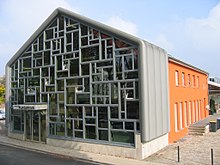
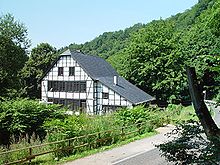
The grinding museum in the Wipperkotten shows the traditional production of knives in the last Doppelkotten preserved in Solingen , also on the Wupper. Loos'n Maschinn in the Widdert district, on the other hand, as a former steam grinding shop, represents the workplace of the Solingen grinders at the end of the 19th century. When they switched from water power to steam power , they called their new Schleifkotten Maschinnen . In 1895 there were 107 of them - one of these buildings was renewed in an exemplary manner, a room and a stairwell have been preserved and are being supported by the Förderverein Industriemuseum Solingen V. operated as an exhibition space under the name Loos'n Maschinn .
Also worth mentioning is the Laurel & Hardy Museum . In Walder Kotten privately operated, it puts the life and work of the stars of Laurel and Hardy original scene. The Museum Plagiarius , probably the world's first museum against product piracy , is located in the head building of the goods halls at the former main station in today's Südpark . It opened on April 1, 2007 as part of the redesign of the area around the former main train station.
The Weegerhof wash house, which has been completely preserved as a museum, is also unique . Opened in 1928 in the middle of the Weegerhof savings and building association estate , it was in operation until 2005. With its original furnishings and machines from the late 1920s, the museum shows the everyday life of housewives at that time. The facility is upgraded with modern, multimedia exhibition technology. There is also a voluntary court museum . It is located in the Hofschaft Buscher Feld in Gräfrath and illustrates the court life of past generations in a museum-preserved, Bergisch half-timbered house .
Galileum Solingen
The Galileum Solingen is the only planetarium in the world that was built in a disused spherical gas container . An additional observatory was placed in a new building next to it. The location is at Walter-Horn-Weg 1 below the Solingen main station in Ohligs. The planetarium can accommodate over 80 visitors. From the foyer on the ground floor to the observatory on the top floor, everything revolves around the subject of stars and space.
music
Solingen is nicknamed Rock City No. in the German rock scene . 1 , which stems from the fact that many rock bands were founded in the city . The band Accept is one of the best known . Other bands also have their roots in the city of blades, including Aclys , Lockjaw and SYPH. In Solingen there is a Cow Club that promotes youth culture and rock music and especially helps young musicians and bands in the city .
Together with the neighboring town of Remscheid, Solingen maintains the Bergische Symphoniker as a publicly sponsored orchestra . There are also various traditional choirs in the city , including the Bergische Männerchor 1801 e. V. which prides itself on being the oldest male choir in Germany. The city also has a municipal music school , which was founded in 1946.
Furthermore, the central office for German-language choral singing in the world has been located in Solingen since 1976 . This sees itself as the central point of contact for German-speaking choirs in different countries and counts the establishment of contact and the exchange of information among the choirs among its tasks. The central office for choral singing has been affiliated with the music school since 2008 .
Solingen has had its own anthem since the end of November 2016. The music video, in which Lord Mayor Tim Kurzbach also plays a small role, shows the city's sights, buildings and events.
Places of remembrance
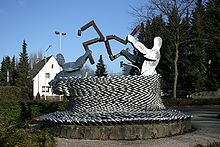
In some places in the city there are monuments , mainly those commemorating locally important personalities or war memorials . The best known, however, is the Solingen Citizens Memorial , which was created as a reaction to the xenophobic murder attempt in 1993 . It is located in front of the Mildred Scheel School in Merscheid and shows two metal sculptures tearing apart a swastika, framed by metal rings with the names of their donors.
Also known are the Rüdenstein monument on the banks of the Wupper near Rüden , the equestrian statue of Count Engelbert I at Burg Castle and the Solingen Liëwerfrau monument on the church steps in the city center. The monument to the local poet Peter Witte is located on the Alter Markt and the metal hemisphere on the Fronhof, which is intended to commemorate the founding point of the city of Solingen. The Czimatis monument on Czimatisplatz , which consists of two whetstones, is named after the Solingen doctor of the same name who successfully combated the dust lung , which mainly occurs in grinders. Near the Walder Church is the grinder memorial by the Solingen artist Henryk Dywan . In front of the Sparkasse in the Unterburg district there is a memorial to the so-called Kiepenkerl who is on the way to transport the burger pretzels . On Unnersberger Allee in the Höhscheid district there is an exposed aggregate concrete sculpture that was initiated in 1997 and is intended to commemorate the town twinning with Gouda in the Netherlands . War memorials can be found in various cemeteries throughout the city. There are also oversized scissors in various places, for example in front of the Blade Museum, which draw attention to the importance of Solingen as a city of blades .
Buildings


The oldest building in Solingen is the medieval tower of the Wald Evangelical Church . The Romanesque west tower was built in the 12th century (around 1150) by Catholic Christians in honor of Saint Sebastian . Today it is the center and the landmark of the Wald district and belongs to the Wald Evangelical Church Community.
The St. Reinoldi Chapel in Rupelrath is at least 600 years old and the second oldest building . The St. Clemens Church, built from 1890 to 1892 by Dominikus Böhm with its two exposed concrete spiers, is a striking landmark in downtown Solingen. The other important structures are located outside the inner city, which was largely destroyed in World War II. The Castle is a reconstructed medieval castle from the 12th century, which owes its historic founding the Count of Berg and long time the residence was before they moved to Dusseldorf. Since it became part of Solingen in 1975, it has been the most visited landmark in today's city of Solingen. In addition, there are other, centuries-old palaces, castles and aristocratic residences in the city, including Caspersbroich Castle and Hackhausen Castle , see also the list of castles and palaces in Solingen .
The Müngstener Brücke is also known nationwide . With a height of 107 meters, it is Germany's highest railway bridge. It connects Solingen with Remscheid and spans the Wupper valley . Another landmark of the city as a whole is the historic center around the market square in the Gräfrath district and the former water tower , which has been converted into a light tower , which is also located in Gräfrath. Despite severe destruction, especially in the inner-city areas of Solingen during the Second World War, an abundance of historical buildings survived in the city. Buildings from the period between 1860 and the First World War in particular have been preserved. Due to the war damage, demolitions and structural densification in the post-war period, however, they are less common in closed ensembles, but rather spread over the entire city area. They are evidence of the great economic importance of Solingen and the entire Bergisch area as an industrial location in the 19th and early 20th centuries. Particularly noteworthy in this context are the northern part of Solingen with the district around Kurfürsten- , Klemens-Horn- , Cäcilien- and Sonnenstraße and the district around Bismarckplatz in Höhscheid.
Typical for Solingen are large and lavish factory owner's villas, which have often been built right next to the factories since early industrialization in the early 19th century. They are preferably located on today's inner-city connecting roads between the formerly independent cities and on the arterial roads. A large number of these villas have been preserved to this day. One of the rare examples of a factory villa of the 18th century is known today as the registry office used house cherry Heath .
There are still many multi-storey Wilhelminian-style apartment buildings in Solingen, most of them in the inner-city areas. Many of them are no longer in their original state due to considerable structural changes from the post-war period, such as the installation of new doors and windows or parts of the ornamentation that were removed. The historical building fabric can often not be recognized and experienced by passers-by , the informative value of many monuments is reduced. However, careful reconstructions led to a restoration of the intended appearance.
In the Solingen court in particular, there are centuries-old Bergisch half-timbered houses in many places , but in most cases they have undergone multiple structural changes. The Dahl in Merscheid, Bech in Wald and Keusenhof , Obenmankhaus or Maubes in Ohligs farms are worth mentioning due to their size and density of historical buildings . In many places , the residential buildings also include Kotten , mills and hammers , which were also often built in half-timbered construction . Due to the humid climate in the Bergisches Land, the half-timbered houses, especially along the ridges , were often clad with slate . Countless of these buildings, which cannot be directly identified as half-timbered houses, are located on the main thoroughfares and side streets throughout the city. Other sights are the Wipperkotten , the last originally preserved double sanding kotten on the Wupper with a grinding shop, museum, monument and designer workshop, as well as the Balkhauser kotten , an old testimony to the craft history of Solingen and today a so-called working memorial . The Sengbach dam , inaugurated in 1903, was one of the first drinking water dams in Germany when it was built . It is located in the southeast of the urban area and supplies large parts of the city with drinking water.
Regular events
The following list is a small selection of the largest festivities in Solingen. The numerous events, some of which have been held regularly for decades, by various small Solingen clubs remain unnamed.
In March, the car show of the local motor vehicle guild takes place in the theater and concert hall, where the latest electric cars from well-known manufacturers are presented. The Solingen Culture Night follows in April , as well as the Walpurgis Festival with witch market at Burg Castle on the night of May 1st . On Mother's Day weekend, the Gräfrath market festival takes place on the historic market square and the local festival of the Nümmen court. As the successor to the discontinued knife maker fair, the Knife Solingen is planned in the theater and concert hall from 2021 , which will serve as a presentation forum for product innovations from Solingen cutlery companies. The Walder Theater Days take place every year in June . Also in June there are a number of so-called small Hahnenköpper festivals in the Solingen courts and the youth culture festival , once initiated by the youth city council. At the beginning of summer, medieval markets take place at Burg Castle .
The Bergische art exhibition in the Kunstmuseum Solingen follows in July. The Echt.Scharf.Solingen.Sommerparty is the largest event in the city center in August, including a stage program on the Neumarkt, a Sunday shopping and a wine festival on the Fronhof. The Zöppkesmarkt , which takes place from the Alter Mark, above the Fronhof and the main street, is Solingen's oldest flea market. It always takes place on the second weekend in September. The Schleiferfest at the historic Wipperkotten on the Wupper is also celebrated in September . In October there is the bridge festival with festive activities in the Solingen districts of Mitte and Ohligs. Finally, in December, the Christmas Dürpel follows in the Ohligser district park on Wittenbergstrasse. The park on Wittenbergstraße will then be converted into a Christmas village with 24 wooden huts decorated for Christmas, where culinary delights and hand-made Advent arrangements will be offered.
Ohligser Dürpelfest
The Ohligser Dürpelfest always takes place in May . The Dürpelfest, in Solingen popularly also briefly Dürpel called, is known far beyond the borders of the blades city, and has developed from a small Ohligser street festival (1975) for the most open-air event developed in the Bergisch city triangle. The Ohligs district festival extends from the main train station via the pedestrian zone (Düsseldorfer Straße) and in the side streets to the market square, where a fair with various rides is offered. Every year over 100,000 people visit the Dürpelfest in Ohligs-Mitte on three days. There are over 40 stands and live music from a wide variety of cover bands and solo artists.
The 46th Dürpelfest will take place from May 28th to May 30th, 2021.
City tours
Guided tours through the city with different topics have been offered since 2004 by the Interest Group City Tours Solingen . In 2014, a total of around 2,300 people took part in the tours offered by 16 city guides on a voluntary basis. The focus is on the industrial history of the city, the brook valleys and the Wupper, the courts, the architectural evidence of the Wilhelminian era or the individual districts themselves.
dialect
The dialect spoken in Solingen is called Solinger Platt . It is one of the Westberg dialects among the Bergisch dialects , which belong to the South Lower Franconian dialect group, which in turn is part of the Limburg dialect group.
The Solinger Platt belongs to the East Limburg / Ripuarian transition area. Thus it is neither clearly part of the Lower Franconian nor the Central German language group, but shares language characteristics of both groups. In Solingen, for example, the word ich is pronounced as iech or as High German I , which points to the Central German language group. The word make , however , is pronounced maken like in Lower Franconian dialects .
sport and freetime
Sports facilities and leisure opportunities

Solingen provides a variety of sports facilities for both professional and amateur athletes. These include eleven sports halls, seven gymnastics and two judo halls. There are also thirty-four gyms and twenty-one outdoor recreational facilities. In addition to the Dorperhof cycling track, the latter includes the baseball stadium on Weyersberg, the Herbert Schade sports facility on Schaberg and the Walder Stadium , as well as various artificial turf pitches . All sports areas have a total size of around 50 hectares .
In Solingen-Mitte there is a blade hall for professional swimming and school swimming . For amateur swimmers, the new Vogelsang indoor swimming pool was opened in the Wald district in 2019 . There are also two open-air swimming pools, the Heidebad in Ohligser Heide and the Ittertal open-air swimming pool in the Wald district run by a private association . There is also an open-air ice rink in Ittertal . Finally, there is also the ice rink operated by Lebenshilfe in the center of Solingen. In the historical amusement park in Ittertal , visitors can find a more than 100 year old water carousel and a fairy tale forest in addition to a few other attractions .
There are two animal parks in Solingen : the Fauna animal park in Gräfrath and the Solingen bird and animal park in Ohligs. There is also a municipal forest school in Glüder . The Rollhaus , which was initiated by the Youth City Council and offers , among other things, an indoor halfpipe system, is particularly attractive for children and young people . One of the largest playgrounds is the Engelsberger Hof adventure playground in Ohligser Heide, which also houses the Schnaufi locomotive, which was restored with donations . A large indoor playground is located with the Tiki Kinderland in the halls of a former hardware store in the Höhscheid district. Three mini golf courses are spread over the city area; They are located at the Scheider Mühle, at the campsite in Glüder and in the bridge park. There are urban youth centers in the city center and in the districts of Gräfrath and Aufderhöhe.
Parks and green spaces, allotments, cemeteries

Green areas and parks make up more than four percent of the total area of Solingen. The largest facilities include the botanical garden in the Wald district with an area of around 7 hectares, the Bärenloch recreation area in the north-east of the city center, the Walder Stadtpark behind the old Walder Town Hall and the now run by the Verein Lebenswerte Solingen e. V. voluntarily maintained Gustav-Coppel-Park in the southeast of the city, as well as the Südpark around the former main station . The bridge park on the Wupperufer in Müngsten , created as part of the Regionale 2006 , is also a popular green space in the center of the Bergisch city triangle . 75 hectares of the total area of Solingen are green spaces, there are also playgrounds and football fields on around 26 hectares.
In addition, the cityscape is dominated by some allotment garden colonies with an estimated share of 75 hectares of the total area.
About 40 hectares make up cemeteries . The park cemetery in the Gräfrath district and the Hermann-Löns-Weg forest cemetery in Ohligs are among the largest.
sports clubs
There are a number of sports clubs in the city that are active in a wide variety of sports . Some of them are very successful in their field and have achieved a number of titles in the past. The following list is sorted alphabetically according to sport and contains the most important Solingen-based clubs that are active in the respective sport. In addition, there are possible successes. For the sake of clarity, the club names are mostly around the year of foundation and the addition e. V. shortened.
American football
In American football , the AFC Solingen Paladins e. V. , who currently (2020) plays in the 2nd Football Bundesliga North.
American square dance
The sport of square dance is mainly operated by the Crossing Swords Solingen .
Automobile sport
The motorsport club Streetgeneration, based in Solingen, shapes the automotive sector .
baseball
The Solingen Alligators are one of the most famous sports clubs in town . The successful baseball sports club plays in the first Bundesliga , was German champion in 2006 and 2014 and runner-up in 2005 and 2013. In addition, he was runner-up in the European Cup in 2004 and 2006.
badminton
In Badminton several Solinger clubs are active. Among them the DJK SG Solingen , the Wald-Merscheider Turnverein, the BSG-Kiesering Solingen in the Solingen Südstadt and the STC Blau-Weiß Solingen, which plays in the regional league . The latter is officially the second oldest badminton club in Germany.
basketball
The sport of basketball is particularly characteristic of BG TSG / DJK Solingen . He plays in the second regional league in North Rhine-Westphalia.
billiards
The sports club SBC Solinger Billard Club, founded in 1920, is active in the area of billiards .
Boules
The Boule Club Solingen 1992 is active in the city in the sport of boules .
Boxing
In the field of boxing , the police sports association Jahn Solingen is worth mentioning .
ice Hockey
Playing in the ice hockey regional league, the sports club EC Bergisch Land is worth mentioning.
figure skating
The Solingen Gymnastics Association for figure skating and ice dancing is active in the field of figure skating .
fencing
Several Solingen clubs are involved in fencing . These are the Wald-Merscheider Turnverein, the Germania Solingen and the Solinger Turnerbund .
Soccer
In the area of football , the former Union Solingen football club is particularly worth mentioning. The Union Solingen was created on July 24, 1974 through the merger of OSC Solingen and VfL Solingen-Wald . Under the name Union Solingen, they were promoted to the 2nd Bundesliga North in May 1975 . In the 1983/84 season the Solingen team reached their sporty zenith with fifth place in the table. A year later, the team reached the quarter-finals in the DFB Cup , where they failed 2-1 at Borussia Mönchengladbach . After the 1988/89 season, the Union rose from the 2nd Bundesliga. In 2012, following a merger with the BSC Aufderhöhe, the Union officially became BSC Union Solingen 1897 e. V. and is a member of the Niederrhein Football Association . BSC Union Solingen has been playing in the district league B (9th league) since 2019.
Is still active in the area of women's football of SV Eintracht Solingen . He plays in the Lower Rhine League, his second team in the District League. In the men's area, VfB Solingen , which plays in the regional league, is the city's highest-class club.
Handball
In Handball is known primarily for the Bergische Handball Club 06 (BHC), which in 2005 from the merger of LTV Wuppertal and the SG Solingen emerged. Today he plays in the handball Bundesliga . In addition, the Ohligser Turnverein 1888 , the Solinger Turnerbund , the Wald-Merscheider Turnverein and the HSV Solingen-Gräfrath are active in handball.
canoe
The field of canoeing is shaped by the Ohligser Turnverein, founded in 1888 .
athletics
In the Athletics are active in 1951 founded Solinger Athletics Club , the Solinger Gymnastics Association and the Forest Merscheider gymnastics club .
Pool billiards
The BC Solinger Niner’s association deals with pool billiards .
Cycling
The two cycling clubs Velo Solingen and RC Schwalbe 03 are active in Solingen. They use the Dorperhof cycling track .
rugby
The Wald-Merscheider Turnverein , founded in 1861 , is particularly active in rugby .
chess
Also one of the most famous Solingen sports clubs is the Solingen SG 1868 , which is active in the field of chess . He plays in the first Bundesliga, is the current German record champion and European Cup winner.
swim
There are several swimming clubs in Solingen. These include the TSV Solingen Aufderhöhe , the swimming club SV Solingen Süd , the SC Solingen , the Ohligser gymnastics club and the DLRG district of Solingen.
sailing
The Solingen Sailing Club deals with sailing .
Sports bowlers
The bowling sector is shaped by the Solinger Kegler club, founded in 1900 , to which the SK 66/99 Solingen and KSF Blau-Weiß Solingen-Hilden clubs belong, the latter is now active in the 2nd Bundesliga.
Sport shooters
There are a large number of sport shooting clubs in Solingen . These are in detail: Höhscheider Schützenverein , St. Sebastianus Schützenbruderschaft Solingen Weeg , Sportschützen Solingen Mangenberg , Schützenverein Solingen-Aufderhöhe , Merscheider Schützenverein , Clay Pigeon and Utility Gun Shooting Club Solingen TUG and SSC Magnum Solingen .
Taekwondo
The police sports association Jahn Solingen is active in the area of Taekwondo .
Diving
Club-style diving is done in the SV Solingen Süd swimming club and in the TSC WASPO Bergisch Land .
tennis
The STC '02 is successful and playing in the first Bundesliga in tennis . In addition, there is the Ohligser Turnverein and the Wald-Merscheider Turnverein , which also have a tennis division.
Table tennis
Championship participation is offered by the following clubs: Solingen Blades, TTC Blau Weiß Solingen and TTC Stöcken 1950 e. V. (formerly TTC Rasspe)
do gymnastics
Active in the sport of gymnastics are the Ohligser Turnverein , Solingen Turnerbund and also the Wald-Merscheider Turnverein .
volleyball
In the field Volleyball deals are Bergischen volleys (until 2017 TSG Solingen Volleys ), the first men's team in the season since the 2016/2017 volleyball league plays. Also worth mentioning are the Ohligser Turnverein and the Wald-Merscheider Turnverein .
Sporting events

In the past, Solingen and its sports facilities have hosted various important sporting events several times. The following events took place in Solingen:
- On August 21 and 22, 1954, Solingen was the venue for the UCI Road World Championships . Over 200 cyclists fought for the world championship title in pouring rain on the specially set up blade ring.
- The first international match of the German national soccer team of the U-15 juniors took place on May 6, 2003 in Solingen. The German selection defeated the Netherlands 1-0 at the Walder Stadium.
- On February 26, 2005, the first snowboard and mountain bike championship took place on an artificial snow ramp on the historic market square in Solingen-Gräfrath under the name Ride the Stairway .
- The second NRW gymnastics festival with a wide variety of event components and with well over 10,000 visitors was held from June 22nd to 25th, 2011 together with the neighboring town of Remscheid in both cities.
- From March 16 to 18, 2012, the German archery championship was held in Solingen.
The regular sporting event with the largest number of participants is the so-called blade run . Every year on Corpus Christi , hundreds of people take part in the runs with different distances through the Solingen city center. Relay races are also part of the program.
Traditional sport
A sport at the end of the 19th century was the Pöhlsches Schieten , similar to the French Boule or the Swiss Bootschen . It has been played again in Solingen since the 1990s.
Personalities
The city's most famous son is the fourth German President Walter Scheel (1919–2016). The FDP politician was first Minister for Economic Cooperation from 1961, then Foreign Minister and Vice Chancellor from 1969 to 1974.
Other personalities are the longtime observer (1949–1977) of the political scene in Bonn, Walter Henkels (1906–1987), the dancer and choreographer Pina Bausch (1940–2009), the artist Erwin Bowien (1899–1972), Telekom - Chief Timotheus Höttges (* 1962), WDR editor-in-chief Jörg Schönenborn (* 1964), writer and philosopher Richard David Precht (* 1964), as well as the actress Veronica Ferres (* 1965), the painter Bettina Heinen-Ayech (* 1937) and the national soccer player Christoph Kramer (* 1991), who became world champion with his team in 2014.
SS-Obersturmbannführer Adolf Eichmann (1906–1962) was also born in Solingen.
Honorary citizen
Since it was unified in 1929, the city of Solingen has only granted honorary citizenship to one person . It is the former Federal President and native Solingen Walter Scheel, who received this award in 1976. However, the city gives further awards to personalities who have made a contribution to the well-being of the city. These are the culture award of the community foundation Solingen 600 , the ring of honor of the city of Solingen and the honorary award of the city of Solingen, the sharpest blade . These awards are given at irregular intervals.
Before the town union, among others, the longtime Solingen local politician Rudolf Schwarz , the longtime district administrator of the Solingen district , Karl Friedrich Melbeck in 1886, and on October 18, 1908 the Solingen entrepreneur Gustav Coppel , who gave the city, among other things, the Coppelstift as a psychological counseling center , made honorary citizens. In addition, this award was given to the longtime Lord Mayor of Solingen and initiator of the city association, August Dicke , who held the office of Lord Mayor for more than 31 years and was finally made an honorary citizen on April 1, 1928. Chancellor Otto von Bismarck was also made an honorary citizen of Solingen in 1895.
Trivia
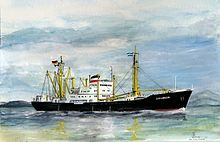
- In the years between 1955 and 1957, a total of five cargo ships of the so-called Solingen class were launched. They were intended for use on the Hamburg-America Line (HAPAG).
- The board game Das Solingen Quiz , produced by City-Spiel-Verlag, has been available since September 2011. It provides interesting information about the sights, the history and the districts of Solingen. All elementary schools in Solingen were provided with class sets for the game by sponsors and sponsors so that it can be used as a supplement to lessons in the third school year, when the subject of local history is on the curriculum.
See also
literature
- Heinrich Silbergleit: Prussia's cities. Memorandum for the 100th anniversary of the town ordinance of November 19, 1808. Ed. on behalf of the board of the Prussian City Council. Heymann, Berlin 1908, OCLC 7907545 .
- Erich Keyser (Ed.): Rheinisches Städtebuch. (= German city book. Volume III 3). On behalf of the working group of historical commissions and with the support of the German Association of Cities, the Association of German Cities and the Association of German Municipalities. Stuttgart 1956, DNB 454817053 .
-
Heinz Rosenthal : Solingen. History of a city . 3 volumes. Braun, Duisburg
- Volume 1: From the beginning to the end of the 17th century. 1969, DNB 457973358 .
- Volume 2: From 1700 to the middle of the 19th century. 1972, ISBN 3-87096-103-1 .
- Volume 3: From the middle of the 19th century to the end of the Second World War. 1975, ISBN 3-87096-126-0 .
- Walther Hubatsch (Ed.): Outline of German administrative history 1815–1945. Volume 7: Rhineland. Marburg an der Lahn 1978, ISBN 3-87969-122-3 .
- Gottlieb Heinrich: Notes and memories from my life. ed. by H.-J. Momberger. Wuppertal 2009, ISBN 978-3-940439-11-6 . (Mayor of Sonnborn, Vohwinkel, Wald)
- Cornelia Konejung, Hans Kadereit: Solingen profiles . Verlag Zinke, Schwerin 2009, ISBN 978-3-932746-94-9 .
- Literature on Solingen in the catalog of the German National Library
- Johannes Fahmüller, Ralf Rogge, Marco Kieser: Villas in Solingen - bourgeois houses between 1860 and 1950 = workbook of the Rhenish preservation of monuments 74th Wernersche Verlagsgesellschaft , Worms 2009. ISBN 978-3-88462-292-6
- J. Beese, K. Dörken: 625 years of Solingen - a handout for the city anniversary. 1999.
- Matthias Kunde: Solingen From Above - The "Thank You Book" for everyone who loves Solingen. 2nd Edition. mavía Verlag, Solingen 2015, ISBN 978-3-9816519-5-9 .
Web links
- Official website of the city of Solingen on solingen.de
- Private collection of diverse information from and about Solingen on solingen-internet.de
- Private portrait of Solingen on tetti.de
- Portal about the city and brand Solingen on solingen-like.de
- Tourism in Solingen on die-bergischen-drei.de
Sources and Notes
- ↑ Population of the municipalities of North Rhine-Westphalia on December 31, 2019 - update of the population based on the census of May 9, 2011. State Office for Information and Technology North Rhine-Westphalia (IT.NRW), accessed on June 17, 2020 . ( Help on this )
- ^ Rp Online: Solingen: Kurzbach on the board of the metropolitan region. In: rp-online.de. February 21, 2017. Retrieved February 21, 2017 .
- ↑ https://www.gesetze-im-internet.de/solingenv/BJNR383300994.html
- ↑ https://www.solinger-tageblatt.de/solingen/solingen-geschuetzt-marke-seit-1938-10053957.html
- ^ A b Hansjörg Laute, Uli Preuss: Echt.Scharf.Solingen. Ed .: Norbert Beleke. 1st edition. Beleke, 2007, ISBN 978-3-8215-0564-0 , pp. 7th f .
- ↑ Klingenstadt Solingen: First name additions for NRW cities approved. In: Rheinische Post. March 19, 2012, accessed March 11, 2015.
- ↑ http://www.obus.info/obus/solingen/
- ↑ Further information on the route memorial on Tetti's blog , accessed on January 26, 2015.
- ↑ https://galileum-solingen.de/impressum/
- ↑ https://www.youtube.com/watch?v=m3XKh_p3aK0
- ↑ Andreas Sassen / Claudia Sassen: A forgotten architectural monument - The Romanesque basilica in forest. In: Romerike Berge. Zeitschrift für das Bergisches Land 57 (2007), issue 3, pp. 13–18, here p. 18
- ↑ https://rp-online.de/nrw/staedte/solingen/denkmal-ruedenstein-steinerner-vierbeiner-wacht-ueber-die-wupper_aid-38258469
- ↑ http://www.solingen-internet.de/si-hgw/geographisch.htm
- ↑ https://www.solinger-tageblatt.de/solingen/ Fakten-ueber-solingen-vermutlich-noch-nicht-wüsten- 12878039.html
- ↑ Statistical data on the urban area ( Memento of the original from March 4, 2016 in the Internet Archive ) Info: The archive link was inserted automatically and has not yet been checked. Please check the original and archive link according to the instructions and then remove this notice. on solingen.de , accessed on January 22, 2015 (PDF; 6 KB)
- ^ Federal Statistical Office (ed.): Historical municipality directory for the Federal Republic of Germany. Name, border and key number changes in municipalities, counties and administrative districts from May 27, 1970 to December 31, 1982 . W. Kohlhammer, Stuttgart / Mainz 1983, ISBN 3-17-003263-1 , p. 292 .
- ↑ Historical overview on the private website solingen-internet.de , accessed on January 24, 2015.
- ↑ The district representatives. ( Memento from January 28, 2015 in the web archive archive.today ) on solingen.de , accessed on January 24, 2015.
- ↑ https://rp-online.de/nrw/staedte/solingen/solingen_aid-39197893
- ↑ RP ONLINE: Solingen: 600 new jobs in the Hansa quarter? . In: www.rp-online.de .
- ↑ http://www.zeitspurensuche.de/02/koti20k.htm
- ^ Martin Oberpriller: Demolition work on the Olbo site in Solingen in full swing . In: rp-online.de .
- ↑ https://www.solinger-tageblatt.de/solingen/spatenstich-heimspiel-ohligs-13354732.html
- ↑ https://rp-online.de/nrw/staedte/solingen/solingen-62-haeuser-und-45-wohnungen-haben-auf-stadion-gelaende-gebaut_aid-4787987
- ↑ https://rp-online.de/nrw/staedte/solingen/solingen-stadt-will-mehr-in-sozialen-wohnungsbau-investieren_aid-48720239
- ↑ https://www.radiorsg.de/artikel/gruene-endung-mehr-sozialwohnungen-fuer-solingen-485604.html
- ↑ https://www.solinger-tageblatt.de/solingen/solingen-2030-fallen-fast-drei-viertel-solinger-sozialwohnungen-13508165.html
- ↑ https://www.radiorsg.de/artikel/solingen-wird-als-wohnort-beliebter-613799.html
- ↑ https://www.solinger-tageblatt.de/solingen/preise-immobilien-stieg-solingen-weiter-13773160.html
- ↑ https://www.solinger-tageblatt.de/solingen/zuschriften-eine-wohnung-ohligs-13567511.html
- ↑ https://www.solinger-tageblatt.de/solingen/immobilienpreise-stieg-solingen-rekordverdaechtig-11854325.html
- ↑ https://rp-online.de/nrw/staedte/solingen/solingen-im-stadtteil-wald-sollen-neue-wohnungen-gebaut-haben_aid-47173717
- ↑ https://www.solinger-tageblatt.de/solingen/verein-sieh-bau-boom-ohligs-chance-13371291.html
- ↑ https://www.solinger-tageblatt.de/solingen/wirtschaft/immobilien-sind-weiter-sehr-gefragt-11833589.html
- ↑ https://rp-online.de/nrw/staedte/solingen/solingen-haus-und-grund-ist-ein-gern-sehener-mieter_aid-47993385
- ↑ Press report on presseportal.de , accessed on March 28, 2015.
- ↑ Climate data for Solingen on wetterdienst.de , accessed on April 15, 2020.
- ↑ Overview of the number of hours of sunshine on holidaycheck.de , accessed on March 28, 2015.
- ^ A b Karlheinz Paffen, Adolf Schüttler, Heinrich Müller-Miny: Handbook of the natural spatial structure of Germany. Sheet 108/109: Düsseldorf / Erkelenz. 1963 and digital version of the associated map (PDF; 7.4 MB)
- ↑ City area according to types of use ( Memento of the original from January 28, 2015 in the Internet Archive ) Info: The archive link was inserted automatically and has not yet been checked. Please check the original and archive link according to the instructions and then remove this notice. on solingen.de , accessed on January 24, 2015 (PDF; 6 KB)
- ↑ Norbert Motzfeld: Open space and green areas in Solingen ( Memento of the original from April 13, 2015 in the Internet Archive ) Info: The archive link was inserted automatically and has not yet been checked. Please check the original and archive link according to the instructions and then remove this notice. , 2006, p. 6 (PDF; 2 KB)
- ↑ Natural monuments ( Memento of the original from November 21, 2015 in the Internet Archive ) Info: The archive link has been inserted automatically and has not yet been checked. Please check the original and archive link according to the instructions and then remove this notice. on solingen.de , accessed on November 20, 2015.
- ^ Website of the Biological Station at bsmw.de , accessed on January 24, 2015.
- ↑ Portrait of the Foundation for the Protection of Animals and Nature in Solingen at stiftung-tier-natur-sg.de , accessed on December 16, 2015.
- ↑ Further information on solingen-natur.de , accessed on January 24, 2015.
- ↑ Norbert Motzfeld: Open space and green areas in Solingen ( Memento of the original from April 13, 2015 in the Internet Archive ) Info: The archive link was automatically inserted and not yet checked. Please check the original and archive link according to the instructions and then remove this notice. , 2006, p. 4 (PDF; 2 KB)
- ↑ Document printed in Erich Wisplinghoff : Rheinisches Urkundenbuch. Older documents up to 1100 , Volume 1: Aachen – Deutz, Peter Hanstein-Verlag, Bonn 1972, No. 131, pp. 190–195; Digitized at the University and State Library Bonn.
- ↑ a b Timeline of the history of Solingen ( Memento of the original from December 27, 2014 in the Internet Archive ) Info: The archive link was inserted automatically and has not yet been checked. Please check the original and archive link according to the instructions and then remove this notice. on solingen.de , accessed on January 25, 2015.
- ↑ Manfred Kohl: Time leaps Solingen Ohlig. Sutton-Verlag, Erfurt 2007, pp. 9-13.
- ^ Jörg Engelbrecht: Civil reforms and imperial power politics on the Lower Rhine and Westphalia . In: Veit Veltzke (Ed.): Napoleon. Tricolor and imperial eagle over the Rhine and Weser. Cologne 2007, p. 101.
- ↑ https://www.solinger-tageblatt.de/solingen/solingen-gedenken-ermordeter-sinti-13573510.html
- ↑ https://rp-online.de/nrw/staedte/langenfeld/langenfeld-solingen-wenzelnberg-massaker-lebte-der-haupttaeter-weiter_aid-49964877
- ^ Rolf Müller, Stadtgeschichte Langenfeld Rheinland , Verlag Stadtarchiv Langenfeld 1992.
- ↑ https://rp-online.de/nrw/staedte/solingen/schueler-erinnern-an-stadtstrich-solingen-langenfeld-an-opfer-des-ns-regimes_aid-37946041
- ↑ https://rp-online.de/nrw/staedte/langenfeld/wenzelnberg-morde-starb-ein-taeter-kurz-danach_aid-19786051
- ↑ http://www.solingen-internet.de/si-hgw/gesch_zahlen.htm
- ↑ https://www.solingen.de/C12581EE0036EAEC/files/bevoelkerungsentwicklung_1949-2017.pdf/%24file/bevoelkerungsentwicklung_1949-2017.pdf
- ↑ https://www.solinger-tageblatt.de/solingen/streit-einwohnerzahl-solingens-13802212.html
- ↑ https://solingenmagazin.de/wie-viele-einwohner-hat-solingen/
- ↑ https://solingenmagazin.de/prognose-solingens-bevoelkerung-wird-weiter-wachsen/
- ↑ https://www.solingen.de/de/aktuelles/prognose-solinger-bevoelkerung-waechst-bis-2040-auf-knapp-167000/
- ↑ https://rp-online.de/nrw/staedte/solingen/solingen-haushalt-2020-eine-schwarze-null-mit-risiken_aid-46089035
- ↑ Federal Statistical Office (ed.): Fachserie 1 Reihe 2.2 “Population with a migration background - Results of the 2015 microcensus”, published on September 16, 2016, corrected on January 27, 2017, download under [1] , page 7
- ↑ https://www.bamf.de/DE/Service/Left/Glossary/_function/glossar.html?lv3=3198544
- ↑ https://www.solinger-tageblatt.de/solingen/tuerken-laufen-italienern-statistik-bald-ersten-rang-13654937.html
- ↑ https://www.solinger-tageblatt.de/solingen/immer-mehr-menschen-haben-nach-solingen-12355439.html
- ↑ Every third person has foreign roots. In: Solinger Tageblatt .
- ↑ Solingen is no longer growing. In: Solinger Tageblatt .
- ↑ https://www.solinger-tageblatt.de/solingen/jeder-vierte-bald-ueber-jahre-12822295.html
- ↑ https://www.solinger-tageblatt.de/solingen/3265-fluechtlinge-wohnen-solingen-12232904.html
- ↑ https://www.solinger-tageblatt.de/solingen/meisten-fluechtlinge-leben-wohnungen-13572154.html
- ^ City of Solingen Religion , 2011 census
- ^ City of Solingen population by denomination 2009–2019 , accessed on May 14, 2020
- ↑ https://www.kath-solingen-west.de/Kontakt/sonstige-kath.-kirchen-in-solingen/
- ↑ a b http://www.solingen-internet.de/si-hgw/gesch_zahlen.htm History of Solingen on solingen-internet.de , accessed on February 13, 2015
- ↑ https://www.solinger-tageblatt.de/solingen/politik-stens-debatte-moschee-12360237.html
- ↑ https://www.solingen.de/de/aktuelles/mulimisches-leben-in-solingen/
- ↑ https://www.moscheesuche.de/moschee/stadt/Solingen/2521
- ↑ https://rp-online.de/nrw/staedte/solingen/ditib-verzichtung-auf-minarett-an-neuer-moschee-in-solingen_aid-39690791
- ↑ How the state drives Salafists out of Solingen. In: The world. June 12, 2012, accessed February 15, 2015.
- ^ Salafists in Solingen. In: Solinger Tageblatt. November 17, 2014, accessed February 15, 2015.
- ^ History of the Jews in Solingen at jewische-gemeinden.de , accessed on May 20, 2015.
- ↑ Information on the history of Judaism in Solingen on the private website solingen-internet.de , accessed on January 26, 2015.
- ↑ Further information on the Coppel family ( Memento of the original from May 25, 2015 in the Internet Archive ) Info: The archive link was inserted automatically and has not yet been checked. Please check the original and archive link according to the instructions and then remove this notice. from Lebenswertes-solingen.de , accessed on May 20, 2015.
- ↑ List of monuments ( Memento of the original dated December 18, 2015 in the Internet Archive ) Info: The archive link was inserted automatically and has not yet been checked. Please check the original and archive link according to the instructions and then remove this notice. on solingen.de , accessed on May 20, 2015.
- ↑ https://rp-online.de/nrw/staedte/solingen/solingen-verein-bildungs-und-gedenkstaette-max-leven-zentrum-gegruendet_aid-45936755
- ↑ https://solingenmagazin.de/verein-bildungs-und-gedenkstaette-max-leven-zentrum-gegruendet/
- ↑ https://stolpersteine-solingen.de/perspektiven-fuer-bildungs-und-gedenkstaette-an-der-max-leven-gasse/1165
- ^ "Search for time tracks: Solingen: Mayor". Retrieved May 27, 2019 .
- ↑ https://rp-online.de/nrw/staedte/solingen/bergischer-schwabe-franz-haug-wird-75_aid-19587619
- ↑ https://www.waz.de/politik/landespolitik/termin-haben-nrw-kommunalwahlen-2020-am-13-september-id227051813.html
- ↑ https://www.waz.de/politik/keine-stichwahl-mehr-landtag-aendert-kommunalwahlrecht-id216936675.html
- ↑ https://www.wr.de/politik/landespolitik/wirbel-ums-wahlrecht-das-steckt-hinter-der-blitzreform-id216923349.html
- ↑ https://www.solingen.de/de/dienstleistungen/10/
- ↑ https://www.solingen.de/de/inhalt/01-vita-oberbuergermeister-tim-kurzbach/
- ↑ https://www.solingen.de/de/inhalt/vita-ralf-weeke/
- ↑ https://www.solingen.de/de/inhalt/vita-ordnungsdezernent-jan-welzel-7444618/
- ↑ https://rp-online.de/nrw/staedte/solingen/ausgestetzt-mit-dem-gefuehl-fuer-die-stadt_aid-21201475
- ↑ https://www.solingen.de/de/inhalt/vita-stadtdirektor-hartmut-hoferichter/
- ↑ https://www.solinger-tageblatt.de/solingen/partments-haben-sich-2020-stellung-10227751.html
- ↑ RP ONLINE: Local politics mid-term review: Citizen participation - learn from others . In: www.rp-online.de .
- ↑ BfS-Bürgergemeinschaft für Solingen e. V. . In: www.facebook.com .
- ↑ Heads become district mayors. In: Solinger Morgenpost. July 15, 2011, accessed March 11, 2015.
- ^ Solingen: elected youth councilor. In: Solinger Bote. May 29, 2015, accessed June 6, 2015.
- ↑ https://www.solinger-tageblatt.de/solingen/prognosen-kaemmerers-verduestern-sich-zunehmend-13766086.html
- ↑ https://www.solinger-tageblatt.de/solingen/weeke-hofft-einen-500-millionen-schnitt-solingen-13375816.html
- ↑ https://www.solinger-tageblatt.de/solingen/kassenkredite-unter-500millionen-euro-13269481.html
- ↑ https://www.solinger-tageblatt.de/solingen/wirtschaft/solinger-sind-spitzenreiter-verschuldung-13221271.html
- ↑ https://rp-online.de/nrw/staedte/solingen/fraktionen-in-solingen-finden-etat-kompromiss_aid-47566291
- ↑ https://rp-online.de/nrw/staedte/solingen/solingen-kaemmerer-ralf-weeke-freut-sich-ueber-etat-kompromiss_aid-47586367
- ↑ https://rp-online.de/nrw/staedte/solingen/fraktionen-in-solingen-finden-etat-kompromiss_aid-47566291
- ↑ https://rp-online.de/nrw/staedte/solingen/solingen-haushalt-2020-eine-schwarze-null-mit-risiken_aid-46089035
- ↑ https://www.solinger-tageblatt.de/solingen/steuerzahlerbund-warnt-solingen-steigenden-zinsen-12813520.html
- ↑ https://rp-online.de/nrw/staedte/solingen/solingen-2021-gibt-es-keine-landeshilfe-mehr-aus-dem-staerkungspakt_aid-36590745
- ↑ Further information on the city symbols at zeitspurensuche.de , accessed on June 6, 2015.
- ↑ Information on Clemens at zeitspurensuche.de , accessed on June 6, 2015.
- ↑ http://www.solingen-internet.de/si-hgw/sg-600jahre.htm
- ↑ City partnerships ( page no longer available , search in web archives ) Info: The link was automatically marked as defective. Please check the link according to the instructions and then remove this notice. on solingen.de , accessed on March 11, 2015.
- ↑ Information on the business location ( Memento of the original from March 15, 2015 in the Internet Archive ) Info: The archive link was inserted automatically and has not yet been checked. Please check the original and archive link according to the instructions and then remove this notice. on solingen.de , accessed on January 25, 2015.
- ↑ Official Homepage of IVSH on ivsh.de , accessed on March 11, 2015.
- ↑ Galvanotechnik on Solingen-like.de, accessed on December 2, 2015.
- ↑ Energizer: Robin Vauth takes on responsibility for the battery division ... ( Memento of the original from April 12, 2015 in the Internet Archive ) Info: The archive link was inserted automatically and has not yet been checked. Please check the original and archive link according to the instructions and then remove this notice. on: presseportal.de , October 31, 2014, accessed April 7, 2015.
- ↑ Editions-Goldbären… In: Solinger Tageblatt. May 4, 2015, accessed May 15, 2015.
- ^ Website of the start-up and technology center at gut-sg.de , accessed on January 25, 2015.
- ↑ Press report of the GuT ( Memento of the original from February 26, 2015 in the Internet Archive ) Info: The archive link was inserted automatically and has not yet been checked. Please check the original and archive link according to the instructions and then remove this notice. at gut-sg.de , accessed on January 25, 2015.
- ↑ Current results - VGR dL. Retrieved January 7, 2019 .
- ↑ Solingen on statistik.arbeitsagentur.de , accessed on January 7, 2020
- ^ Federal State of North Rhine-Westphalia. Federal Employment Agency, accessed on January 7, 2019 .
- ↑ J. Beese, K. Dörken: 625 years of Solingen - a handout for the city anniversary. 1999.
- ↑ Background of the patent process between Gillette and Solingen companies. In: time online. February 26, 1965, accessed March 5, 2015.
- ↑ Solingen is now introducing itself on its place name signs as "City of Blades". ( Memento of the original from February 20, 2013 in the Internet Archive ) Info: The archive link was automatically inserted and not yet checked. Please check the original and archive link according to the instructions and then remove this notice. Press information on the official inauguration of the new signs on solingen.de, accessed on March 11, 2015.
- ↑ https://www.solinger-tageblatt.de/solingen/solingen-accuride-will-massiv-stellen-streichen-12200364.html
- ↑ https://www.solinger-tageblatt.de/solingen/adient-will-stellen-solinger-standort-streichen-13838589.html#:~:text=Die%20Mitarbeiter%20am%20Adient%2DStandort,sind%20erneut% 20of% 20 job cuts% 20 affected. & Text = only% 20 eight% 20 months% 20 after% 20the% 20y% C3% BCangsten% 20social plan% 20% E2% 80% 93% 20 union% 20is% 20shocked .
- ↑ Leadership duo for the Awo. ( Memento from February 9, 2015 in the web archive archive.today ) In: Solinger Tageblatt. November 28, 2012, accessed February 9, 2015.
- ↑ Bergische lowers the contribution rate. In: Solinger Morgenpost. December 18, 2014, accessed February 9, 2015.
- ↑ Company portrait in the Solinger Morgenpost, accessed on March 4, 2015.
- ↑ https://www.bong.de/kontakt/
- ↑ Crown Prince secures the location. In: Solinger Tageblatt. January 30, 2015, accessed April 12, 2015.
- ↑ Brangs + Heinrich is preparing for the future. In: Solinger Morgenpost. June 29, 2013, accessed May 18, 2015.
- ↑ http://bss-materialflussgruppe.de/bss/profil.html
- ↑ https://www.ccl-design.de/navigation/kontakt/europa-ccl.html
- ↑ https://www.codecentric.de/ueber-uns/unternehmen/
- ↑ Interview with the Bethanien board of directors in the Solinger Tageblatt on July 20, 2015.
- ^ Report of the Solinger Morgenpost from February 24, 2014, accessed on April 19, 2015.
- ^ Article in the Solinger Morgenpost from June 6, 2014, accessed on March 29, 2015.
- ^ Report of the Westdeutsche Zeitung of April 24, 2014, accessed on February 9, 2015.
- ↑ Company portrait in the Solinger Tageblatt of March 17, 2015, p. 22.
- ↑ Company website , accessed May 15, 2015.
- ↑ Portrait in the Solinger Tageblatt of June 5, 2013, p. 17.
- ^ Report in the Solinger Tageblatt from February 24, 2015.
- ↑ https://www.solinger-tageblatt.de/solingen/solingen-sparkasse-knackt-3-millionen-marke-13578131.html
- ↑ Company portrait in the Solinger Tageblatt from June 27, 2013.
- ^ Report of the Solinger Tageblatt from September 19, 2014, accessed on May 27, 2015.
- ^ Homepage of the VS company , under the VS Guss / Employees tab, accessed on May 15, 2015.
- ↑ Solinger Tageblatt. February 27, 2015.
- ↑ [2] Solinger Tageblatt of October 6, 2016.
- ↑ Company portrait in the Solinger Tageblatt on July 9, 2013.
- ^ Report of the Solinger Morgenpost from February 5, 2014, accessed on May 15, 2015.
- ^ Bergische Wirtschaft ( IHK magazine ), issue 5/2015, p. 41.
- ↑ Industrial oaks on solingen-internet.de , accessed on February 9, 2015.
- ↑ Security from Solingen
- ^ Chronicle of the Bremshey company ( Memento from July 8, 2014 in the Internet Archive )
- ↑ https://rp-online.de/nrw/staedte/solingen/stadt-solingen-praesentiert-neue-fussgaengerzone-in-ohligs_aid-49006053
- ↑ http://bilder-von-solingen.de/html/die_dusseldorfer_str__u_a_.html
- ↑ https://www.solinger-tageblatt.de/solingen/vier-millionen-euro-ohligser-city-12993306.html
- ↑ https://rp-online.de/nrw/staedte/solingen/das-herzstueck-von-ohligs_aid-11427803
- ^ Report of the Solinger Tageblatt from May 28, 2015, accessed on July 25, 2015.
- ↑ http://www.solingen-wald.com/tag/walder-rundling/
- ↑ https://rp-online.de/nrw/staedte/solingen/wochenmaerkte-haben-in-solingen-jetzt-neu-ausgeschritten_aid-46465159
- ↑ https://rp-online.de/nrw/staedte/solingen/solingen-neues-hotel-auf-der-ostseite-des-hauptbahnhofes-bis-ende-2022_aid-51336529
- ↑ https://rp-online.de/nrw/staedte/solingen/stadt-solingen-plant-behelfsbruecke-zu-den-bahngleisen_aid-45911973
- ↑ https://rp-online.de/nrw/staedte/solingen/holiday-inn-kom-nach-solingen-ohligs_aid-39627001
- ^ Report of the Solinger Morgenpost dated December 10, 2006, accessed on January 24, 2015.
- ↑ Information on Central Station ( Memento of the original from January 28, 2015 in the Internet Archive ) Info: The archive link was inserted automatically and has not yet been checked. Please check the original and archive link according to the instructions and then remove this notice. on solingen.de , accessed on January 24, 2015.
- ↑ https://www.solinger-tageblatt.de/solingen/busbahnhof-ohligs-orientierung-faellt-noch-schwer-3974288.html
- ↑ https://rp-online.de/nrw/staedte/solingen/ohligs-laeutet-am-bahnhof-die-zukunft-ein_aid-18737487
- ↑ "BOB" goes on maiden voyage with ST readers - accessed on June 18, 2018
- ↑ Solingen receives notification of approval for 32 new BOBs. Solingenmagazin , March 1, 2019, accessed on July 14, 2019 .
- ↑ https://rp-online.de/nrw/staedte/solingen/bob-startet-ab-montag-in-solingen-wieder-durch_aid-49231915
- ↑ https://rp-online.de/nrw/staedte/solingen/ohligser-cdu-beerdigt-a-3-schluss-zur-vieh-in-solingen_aid-44160315
- ^ Report of the Solinger Tageblatt from September 23, 2011, accessed on January 24, 2015.
- ↑ Overview of the Round Table for Cyclists ( Memento of the original from October 5, 2015 in the Internet Archive ) Info: The archive link was inserted automatically and has not yet been checked. Please check the original and archive link according to the instructions and then remove this notice. on solingen.de , accessed on July 27, 2015.
- ↑ Bergbahntrasse ( Memento of the original from October 5, 2015 in the Internet Archive ) Info: The archive link was inserted automatically and has not yet been checked. Please check the original and archive link according to the instructions and then remove this notice. on solingen.de , accessed on July 27, 2015.
- ↑ Reconstruction of Konrad-Adenauer-Straße ( Memento of the original from October 5, 2015 in the Internet Archive ) Info: The archive link was automatically inserted and not yet checked. Please check the original and archive link according to the instructions and then remove this notice. on solingen.de , accessed on July 27, 2015.
- ↑ Overview of some hiking trails on berg-mark-wege.de , accessed on July 27, 2015.
- ↑ Project overview City 2013 ( Memento of the original from February 27, 2015 in the Internet Archive ) Info: The archive link was inserted automatically and has not yet been checked. Please check the original and archive link according to the instructions and then remove this notice. on solingen.de , accessed on February 27, 2015 (PDF document)
- ↑ Information on the project under the tab Die Straße on jugendberufshilfe-solingen.de , accessed on February 25, 2015.
- ↑ https://solingenmagazin.de/
- ↑ Studiowelle 2. Retrieved February 25, 2018 .
- ↑ https://www.solinger-tageblatt.de/solingen/letzt-solinger-hauptschule-wird-juli-verbind-12348754.html
- ↑ https://rp-online.de/nrw/staedte/solingen/solinger-und-remscheider-maler-und-lackierer-innung-kooperieren_aid-4933600
- ↑ https://www.solinger-tageblatt.de/solingen/mildred-scheel-schule-millionen-neubau-9934942.html
- ^ Alexander Coppel Comprehensive School . In: www.habenschule-solingen.de .
- ↑ http://www.habenschule-ohligs.de/schwerpunkte/individuelle-foerderung.html
- ↑ https://www.solinger-tageblatt.de/solingen/vierte-otalschule-startet-oberstufe-13535175.html
- ↑ reporting on this. ( Page no longer available , search in web archives ) Info: The link was automatically marked as defective. Please check the link according to the instructions and then remove this notice. In: Solinger Tageblatt
- ↑ City of Solingen wants to put 125 million in schools on rp-online, accessed on March 6, 2019
- ↑ http://www.sekundarschulesolingen.de/homepage/
- ↑ History of the Cobra at home.wtal.de , accessed on March 11, 2015.
- ↑ Cobra homepage at cobra-solingen.de, accessed on March 11, 2015.
- ↑ Focus Online press report from September 29, 2014, accessed on January 27, 2015.
- ^ Report of the Jüdischen Allgemeine from January 8, 2015, accessed on May 22, 2015.
- ^ Waschhaus Weegerhof on kulturserver-nrw.de , accessed on February 24, 2015.
- ↑ Information about the museum at hofschaftsmuseum.de , accessed on April 9, 2015.
- ↑ https://rp-online.de/nrw/staedte/solingen/planetarium-in-solingen-das-galileum-brummt_aid-46102223
- ↑ https://solingenmagazin.de/galileum-eroeffnet-ein-tag-fuer-die-geschichtsbuecher-video/
- ↑ https://rp-online.de/nrw/staedte/solingen/solingen-familien-reisen-durch-das-universum_aid-40644881
- ↑ Cow Club website at cowclub.de , accessed on July 27, 2015.
- ↑ Chronicle of the Music School ( Memento of the original from August 20, 2015 in the Internet Archive ) Info: The archive link was inserted automatically and has not yet been checked. Please check the original and archive link according to the instructions and then remove this notice. at musikschlue-solingen.de , accessed on July 27, 2015.
- ↑ website of the Central Office choral singing on zentralstelle-chorgesang-solingen.de , accessed on July 27, 2015.
- ^ City of blades Solingen - See You - Solingen. In: www.solingen.de. Retrieved December 3, 2016 .
- ↑ youseeseeyou: SEE YOU - Solingen [Official Video]. November 29, 2016, accessed December 3, 2016 .
- ↑ Monuments on solingen-internet.de , accessed on February 11, 2015.
- ↑ Information on individual monuments at zeitspurensuche.de , accessed on February 11, 2015.
- ↑ https://rp-online.de/nrw/staedte/solingen/solingen-2019-ist-grosses-jubilaeumsjahr-rund-um-die-walder-kirche_aid-33339987
- ^ Fahmüller, Rogge, Kieser: Villas in Solingen - bourgeois houses between 1860 and 1950
- ↑ https://www.solinger-tageblatt.de/solingen/neue-messe-knife-schon-anmmeldung-12965647.html
- ↑ https://www.solinger-tageblatt.de/solingen/solingen-brueckenfest-2019-startet-freitag-neuen-angeboten-13162245.html
- ↑ https://rp-online.de/nrw/staedte/solingen/solingen-weihnachtsduerpel-lockt-nach-ohligs_aid-34609917
- ↑ https://solingenmagazin.de/ohligser-weihnachtsduerpel-am-zweiten-adventswochenende/
- ↑ https://www.radiorsg.de/artikel/duerpelfest-ist-abgesagt-540087.html
- ↑ https://solingenmagazin.de/coronavirus-ohligser-duerpelfest-abgesagt/
- ↑ https://rp-online.de/nrw/staedte/solingen/solingen-veranstalter-sagen-duerpelfest-in-ohligs-ab_aid-49643727
- ↑ https://solingenmagazin.de/100-000-menschen-besuchen-das-duerpelfest/
- ↑ https://rp-online.de/nrw/staedte/solingen/100000-besucher-zum-duerpel-fest-erwartet_aid-20933419
- ↑ https://www.solinger-tageblatt.de/solingen/duerpelfest-solingen-veranstalter-rechnet-100000-besuchern-12294911.html
- ↑ Web presence of IG Stadtführung on stadtfuehrungen-solingen.de , accessed on April 18, 2015.
- ^ Report of the Solinger Morgenpost from April 18, 2015, accessed on April 18, 2015.
- ↑ Overview of the sports facilities ( Memento of the original from February 22, 2015 in the Internet Archive ) Info: The archive link was inserted automatically and has not yet been checked. Please check the original and archive link according to the instructions and then remove this notice. on solingen.de , accessed on February 22, 2015.
- ↑ a b c Norbert Motzfeld: Open spaces and green spaces in Solingen ( Memento of the original from April 13, 2015 in the Internet Archive ) Info: The archive link was inserted automatically and has not yet been checked. Please check the original and archive link according to the instructions and then remove this notice. , 2006, p. 8 (PDF; 2 KB)
- ↑ https://www.solingen.de/de/inhalt/ein-familienbad-ohne-barrieren/
- ↑ https://www.solinger-tageblatt.de/lokalsport/paladins-sind-premiere-geruestet-9833156.html
- ↑ Home & News . In: www.unionsolingen.de .
- ↑ RP ONLINE: Football: BSC Union announces the first team . In: www.rp-online.de .
- ↑ Nils Buchmann: VfB celebrates a successful Spinella debut. Solinger Tageblatt, accessed December 9, 2018 .
- ↑ Solingen after the heartbeat finals champions, report from April 24, 2016 on schachbundesliga.de
- ↑ Information about the Turnfest at turnfest2011.de , accessed on February 11, 2015.
- ↑ The website of the Klingenlauf on klingenlauf.de , accessed on April 6, 2015.
- ^ Heinz Rosenthal: Solingen - history of a city. Ed .: Rüdiger Schneider-Berrenberg. Volume 3. Walter Braun Verlag, Duisburg 1975, ISBN 3-87096-126-0 .
- ↑ Official website of the Solingen Quiz , accessed on February 22, 2015.


